Community Resources for Mental Health Support | Dr. Chandril Chugh
Your mental health is key to feeling good. It's about how you think, feel, and act. Many adults in the U.S. deal with depression and anxiety.
Ignoring your mental health can harm your life and body. That's why adult mental health programs are so important. They help you face mental health issues and grow stronger.
These programs give you treatments, support, and ways to stay mentally healthy. By caring for your mental health, you can live better, strengthen bonds, and tackle daily tasks easier. If you're facing mental health problems or just want to stay well, these resources can help.
Dr. Chandril Chugh, a top mental health expert, stresses the need for these resources. Whether you're battling a condition or just want to focus on your mental health, these programs can change your life for the better.
Understanding the Importance of Mental Health
Your mental health is more than just not having a mental illness. It's about feeling good and handling life's stresses. It's also about working well and helping your community. Good mental health is key for a happy life.
What is Mental Health?
Mental health is about your emotional, psychological, and social well-being. It's not just about not having a mental illness. It's about feeling emotionally, mentally, and socially healthy. When you're mentally healthy, you can handle life's ups and downs. You can also build strong relationships and live a fulfilling life.
The Prevalence of Mental Illnesses
Mental illnesses are more common than you might think. In the United States, over 1 in 5 adults have a mental illness. Common mental health issues include anxiety, depression, and psychotic disorders. These can greatly affect a person's life, relationships, and well-being.
The Consequences of Neglecting Mental Health
Ignoring your mental health can lead to serious problems. Untreated mental health issues can cause physical health problems. They can also harm personal relationships and work life. There's also a higher risk of substance abuse and suicide. Taking care of your mental health is vital for a good life.
Mental Health Programs for Adults
Good mental health is key for adults to enjoy life fully. Luckily, many mental health programs are here to help. They offer support and resources to improve well-being and prevent issues.
These programs offer services like therapy, counseling, and support groups. They help adults cope with mental health challenges. This way, they can live better lives.
- Federal resources, such as the Substance Abuse and Mental Health Services Administration (SAMHSA) helpline and online locator, can connect individuals with local mental health services.
- Universities and colleges often have on-campus mental health centers or peer support groups to assist students.
- Employee Assistance Programs (EAPs) offered by employers can provide free and confidential access to mental health services, as well as resources related to substance use, grief, and trauma.
Adults can improve their well-being by using these programs. They help prevent mental health problems and offer support. Taking care of mental health is vital for a happy life.

Overcoming Barriers to Accessing Mental Health Services
Getting mental health services can be hard for many. Issues like no insurance, money problems, stigma, and few providers make it tough. We need to tackle these social issues to help more people get the care they need.
Addressing Social Determinants
Social factors like money, education, support, and environment affect mental health access. By working on these, we can make mental health care easier and fairer for everyone.
- Expand insurance to make mental health services affordable for all.
- Boost funding for community mental health programs to help more people.
- Teach people about mental health to lower stigma and encourage seeking help.
- Put mental health services in primary care to make it easier to get help.
By tackling barriers and focusing on social factors, we can make mental health care better. This approach helps everyone get the support they need for their emotional health.
The Role of Communities and Workplaces
Communities and workplaces are key in supporting adult mental health. They offer education, support groups, and resources. This helps people learn, feel less alone, and get the help they need.
In the workplace, mental health programs are available. These include counseling, stress management, and policies for better work-life balance. This creates a supportive space for employees to focus on their mental health.
Together, communities and workplaces can fight mental health stigma. They ensure people get the support they need. They tackle issues like poverty and unstable housing, and use arts and culture to improve well-being.
A 2015 study found community efforts can help racial and ethnic minorities. A 1988 study showed the value of a multi-faceted approach in health promotion.
- Mutual aid groups grew from 50 to over 500 by May 2020, showing community support needs.
- Peer support in mental health settings improves well-being and reduces hospitalizations, research shows.
- Doulas and midwives help reduce C-section rates and improve maternal health, which is vital.
Communities and workplaces can build a strong support system. This addresses many needs, leading to better mental health and a stronger community.

Investing in Mental Health: A Societal Imperative
Investing in mental health programs is key for our society. Poor mental health can cause high healthcare costs and lost productivity. But, focusing on mental health brings big benefits that make the investment worth it.
Mental health investment is crucial for our healthcare system and society. It helps build stronger, more resilient communities. This leads to a better quality of life for everyone. It's not just a moral duty, but a smart move for a thriving society.
The impact of mental health on society is huge. Studies show that over 1 in 5 adults in the U.S. have a mental health issue. About 1 in 25 face serious problems like schizophrenia or major depression. Ignoring mental health can lead to physical health issues, financial problems, and increased risks of substance abuse and suicide.
Investing in mental health programs can have a positive effect. These programs can improve life quality and strengthen relationships. They help manage everyday challenges better. Mental health promotion and prevention strategies aim to enhance well-being and reduce mental health risks.
By prioritizing mental health, we can make society more equitable and inclusive. Expanding insurance to include more mental health services is key. So is providing community resources and workplace support to increase access to care and reduce stigma.
Investing in mental health is not just personal, but a societal must. It can change our healthcare system, boost productivity, and create a resilient community. Let's work together to make mental health a priority and build a brighter future for everyone.
Mental Health Challenges in Young Adulthood
Young adults face unique mental health challenges as they enter adulthood. This stage, from ages 16 to 24, sees big changes in their bodies, feelings, and social lives. These changes make them more likely to develop mental health issues.
Unique Developmental Period of Transition
The move to adulthood is exciting but also stressful for young people. They make big choices about school, work, and friends. This can lead to mental health problems. About one in five young adults deal with depression or anxiety.
High Prevalence of Mental Health Conditions
Mental health issues often start in childhood, teens, or young adulthood. These problems have grown a lot in recent years. Young adults, including teens and young adults, see a big rise in mental health issues, especially during the COVID-19 pandemic.
Anxiety, depression, self-harm, and suicidal thoughts are more common among young adults. The age when depression starts has dropped a lot over the years. These issues hit hard on young adults who are already facing big challenges.

It's very important to help young adults with their mental health. They face many stresses and big changes. We need to make sure they have access to mental health help, support, and tackle unfair systems.
Risk Factors and Determinants of Mental Health
Keeping good mental health is hard because many things can affect it. For young adults, their social and environmental surroundings are key. Having a loving family, good friends, and feeling part of a community helps a lot.
But, facing money troubles, violence, or bad parenting can harm their mental health. These issues can lead to problems like depression and anxiety.
Socio-Environmental Influences
The place young adults live and the people they meet greatly affects their mental health. Living in poor areas, not having enough food, or bad housing can raise the risk of depression. Feeling left out or facing discrimination also hurts their mental health.
Adverse Life Experiences and Trauma
Going through tough times, like abuse or losing someone close, can really affect young adults. These experiences can cause anxiety, depression, and PTSD. Being exposed to violence or facing many forms of discrimination also harms their mental health.
It's important to tackle the mental health risk factors and social determinants of mental health to help young adults. Understanding the effects of trauma and mental health is also key to giving them the right support.
Common Mental Health Issues in Young Adults
Young adults face many mental health challenges as they grow up. Anxiety and depression are big problems, hitting about 4.6% of 15-19-year-olds for anxiety and 2.8% for depression.
Behavioral and eating disorders also hit young people hard. ADHD affects 2.4% of 15-19-year-olds. Eating disorders like anorexia and bulimia are common too. Suicidal thoughts and substance abuse add to their mental health struggles.
These issues deeply affect a young adult's school, social, and personal life. It's key to get help early and have the right support. This helps young people deal with these problems and find healthy ways to cope.
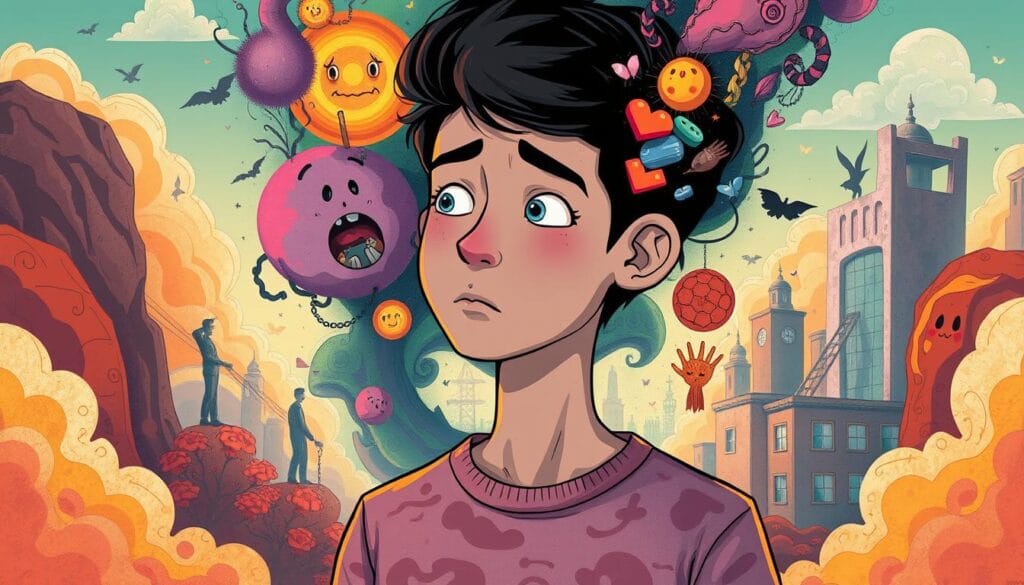
- Anxiety disorders, such as generalized anxiety, social anxiety, and panic disorders, affect around 4.6% of 15-19-year-olds.
- Depressive disorders impact 2.8% of 15-19-year-olds, leading to low mood, lack of interest, and suicidal ideation.
- ADHD affects 2.4% of 15-19-year-olds, contributing to behavioral challenges.
- Eating disorders, including anorexia and bulimia, commonly emerge during adolescence and young adulthood.
- Substance abuse and suicidal behavior further compound the mental health struggles of young adults.
Community Resources for Mental Health
Your local community is a great help for mental health. They offer support groups, counseling, and more. These resources can improve your well-being.
Start with the MHA Affiliate Network. It connects you with local Mental Health America (MHA) groups. They provide crisis help, support groups, and referrals.
Use the SAMHSA Treatment Locator for addiction and mental health services. It helps find counseling and therapy in your area.
If you're in crisis, the MHA website has a crisis section. It lists hotlines, text lines, and chat services for 24/7 help.
Local programs and partnerships also help. Check with your city or state for mental health services.
Remember, your mental health is key to your well-being. Use community resources to get the help you need.
Conclusion
Mental health is key to feeling good about yourself. But, many people in the U.S. face mental health challenges. Ignoring your mental health can hurt your life, health, and social and economic life.
Mental health programs for adults are very important. They offer support, treatments, and ways to build strength. This helps people deal with mental health issues.
We need to make it easier to get help for mental health. We should also get support from our communities and workplaces. Investing in mental health is important for everyone.
By focusing on mental health, we can help people and make our communities stronger. Talking openly about mental health and getting help is a big step. It helps us all feel better.
You're not alone in your mental health journey. Getting help and connecting with your community can change your life. Let's work together to make mental health a priority for everyone.
FAQ
What is mental health?
Mental health is about feeling good and handling life's stresses. It's about working well and helping others. It's not just being free from illness, but being emotionally and socially well too.
How prevalent are mental health issues?
Over 1 in 5 adults in the U.S. have a mental illness. Common issues include anxiety, mood, and psychotic disorders.
What are the consequences of neglecting mental health?
Ignoring mental health can harm your wellbeing and life quality. It can lead to physical health problems and challenges in relationships and work. It also raises the risk of substance abuse and suicide.
What do mental health programs for adults offer?
Mental health programs for adults offer treatments like psychotherapy and medication. They also provide counseling, support groups, and skills workshops. These programs help improve well-being, prevent problems, and aid in recovery.
What are the barriers to accessing mental health services?
Many face barriers to mental health services. Issues include lack of insurance, financial constraints, stigma, and limited providers.
How can communities and workplaces support adult mental health?
Communities and workplaces can offer mental health education and support groups. They can also provide resources to help people learn and find help. Workplaces can offer counseling, stress management, and policies for better work-life balance.
Why is investing in mental health programs important for society?
Investing in mental health programs is crucial for society. Poor mental health can lead to high healthcare costs and decreased productivity. But good programs bring back the investment with better outcomes for everyone.
What unique mental health challenges do young adults face?
Young adults face big changes in physical, emotional, and social areas. This makes them more likely to struggle with mental health issues like anxiety, depression, and behavioral disorders.
What factors influence the mental health of young adults?
The environment and people around young adults shape their mental health. Supportive families, good friends, and community help them stay strong. But economic problems, violence, or tough parenting can increase mental health issues.
What are the common mental health issues among young adults?
Young adults often face mental health challenges like anxiety disorders, depressive disorders, ADHD, conduct disorders, and eating disorders. These can greatly affect their academic, social, and personal lives.
What community resources are available for mental health support?
Many community resources support the mental health of young adults and adults. These include support groups, counseling services, educational programs, and wellness initiatives. They are offered by local organizations, healthcare providers, educational institutions, and government agencies.
Source Links
- Mental Health In Young Adults
- Practice Implications for Acute Ischemic Stroke during the COVID-19 Pandemic for the Indian Scenario: Realistic and Achievable Recommendations by the Society of Neurocritical Care (SNCC), India
Best Therapy for Depression: Effective Treatments Explained | Dr. Chandril Chugh
Finding the right therapy for depression is a big step. Dr. Chandril Chugh is here to help. He guides you through treatments that can change your life for the better.
Depression is a tough condition that affects many areas of life. It can make daily tasks hard, hurt relationships, and lower your quality of life. Dr. Chugh shows you evidence-based treatments that can help.
There are many treatments for depression. This includes medicines that fix brain imbalances and psychotherapy that changes your mind. Dr. Chugh's insights help you make smart choices and find your way to recovery.
If you're feeling sad, tired, or worthless, this guide is for you. It gives you the tools to beat depression and get your life back. Let's find the best therapy for depression together and start your journey to wellness.
Understanding Depression: A Silent Battle
Depression is a complex mental health issue. It deeply affects a person's life. It's not just feeling sad for a while. It's a long-lasting feeling of sadness and hopelessness.
Depression shows up in many ways. It can change how you think, feel, and even your body.
Symptoms and Manifestations of Depression
Depression symptoms vary from person to person. Some common signs include:
- Persistent feelings of sadness, emptiness, or hopelessness
- Loss of interest or pleasure in activities once enjoyed
- Changes in sleep patterns, such as insomnia or excessive sleeping
- Significant weight loss or gain, with changes in appetite
- Difficulty concentrating, making decisions, or remembering things
- Feelings of worthlessness or excessive guilt
- Recurrent thoughts of death or suicide
These symptoms can make daily life hard. It's tough to work, socialize, or even take care of yourself.
Prevalence of Depression: A Growing Concern
Depression is a big problem worldwide. The World Health Organization says it's the top cause of disability. Over 300 million people suffer from depression globally.
In the United States, about 15 million adults have depression. The number of people with depression is growing. Diet, lifestyle, and environment play a role.
It's important to know about depression. It shows how crucial it is to get help and find effective treatments. This can help fight depression and improve mental health.
The Importance of Seeking Professional Treatment
When dealing with depression, getting professional help is key. Depression is a complex issue that needs a team effort. This team includes doctors, therapists, and friends.
By talking to mental health experts, you get a correct diagnosis. You also find the best ways to treat it.
Research shows that therapy like CBT and interpersonal therapy is very helpful. These therapies help you understand and deal with depression. They also teach you how to feel better mentally and emotionally.
For severe depression, you might need both medicine and therapy. Medicine can help with symptoms. Therapy works on the deeper issues.
Finding the right therapist is important. You might need to try a few before you find the right one. Remember, asking for help is brave and can really help you get better.

Don't let shame stop you from getting help. Depression can be treated, and with the right support, you can take back your life. Start by talking to a doctor or therapist today.
Medication Options for Treating Depression
Medication is key in managing depression. It helps bring relief and balance back. There are many antidepressant types, each with its own benefits. Knowing these can help find the right fit for you.
Antidepressant Categories and Their Mechanisms
Antidepressants are grouped by how they work in the brain. You have SSRIs, SNRIs, Tricyclics, Atypicals, and MAOIs. Each targets different brain chemicals to fight depression.
Finding the Right Medication: A Personalized Approach
Finding the right depression medication is all about you. What works for one might not work for another. Your doctor will look at your history and symptoms to choose the best option.
It might take some trying to find the right fit. But remember, medication is just part of the plan. Your doctor might also suggest therapy and lifestyle changes to help you feel better.
Psychotherapeutic Interventions: Beyond Medication
Medication is not the only way to treat depression. There are other methods that can help too. Cognitive Behavioral Therapy (CBT) is one of them. It helps people change their thinking and feel better.
Cognitive Behavioral Therapy (CBT): Reshaping Thought Patterns
CBT is a type of therapy that helps people change their negative thoughts. It teaches them new ways to think and act. This way, they can fight off depression.
Research shows CBT works well for depression. Adults usually get 20-24 sessions of therapy. Interpersonal Psychotherapy (IPT) also helps, focusing on relationships. Adults get 16 to 20 sessions on average.
CBT helps people understand their thoughts better. It teaches them how to manage their symptoms. This method is great for keeping depression away and improving life.
Lifestyle Modifications for Managing Depression
Simple changes in your lifestyle can help manage depression. These include exercise, light therapy, and nutrition. They are powerful tools for better mental health.
Exercise as an Antidepressant
Regular exercise is a proven way to fight depression. Just 30 minutes a day, 3 to 5 times a week, can help. It reduces stress, boosts mood, and improves sleep.
Walking, swimming, or cycling are great options. They offer many benefits.
Light Therapy for Seasonal Affective Disorder
Light therapy is a big help for those with seasonal affective disorder (SAD). It involves sitting in bright light for 30 minutes a day. This can ease winter depression symptoms.
Nutrition and Sleep: Essential Components
Eating well and sleeping right are key to managing depression. Foods rich in omega-3s, magnesium, and vitamins B and C help your mood. A good bedtime routine and regular sleep schedule also help.
By making these lifestyle changes, you can manage your depression better. Small steps can lead to big improvements in your mental health.

Mindfulness and Self-Care: Embracing Inner Strength
Mindfulness and self-care are key in fighting depression. They help you take charge of your recovery. By using meditation and deep breathing, you learn to know yourself better and control your feelings. Self-care activities like exercise and spending time with friends also help manage depression.
Mindfulness is about being in the moment. It helps you see your thoughts and feelings clearly. Adding mindfulness to your day, like meditation or journaling, helps you grow.
Self-care is also crucial for beating depression. It covers your body, mind, and heart. Self-care for depression means getting enough sleep, eating well, and exercising. It also means doing things you love and getting support from others.
By focusing on mindfulness for depression and self-care, you build inner strength. This way of dealing with depression can greatly improve your mental health and life quality.
Your path to wellness is your own. Finding the right mix of therapies and self-care is important. Mindfulness and self-care can open the door to a happier, more balanced life.
Building a Support System: Overcoming Isolation
Depression can make you feel alone, which makes it worse. But, having a strong support system can help. It can make you feel connected and part of a community.
One in six American adults deals with mental health issues, says the U.S. National Institute of Mental Health. A good support system can lead to better well-being and longer, healthier lives. It helps reduce depression, anxiety, and stress, which are key in getting better.
Being around people who support you can help you feel more connected. They encourage you to eat well and exercise. They also help distract you from negative thoughts.
Getting help from professionals in your support system is also important. The World Health Organization (WHO) says social isolation can make depression worse. It's a big problem worldwide, causing 15% of all cases.
- Build a support network of family, friends, and trusted communities.
- Participate in support groups or join online communities to connect with others facing similar challenges.
- Seek out referrals from healthcare providers or mental health professionals to access additional resources and support.
- Engage in activities that promote social interaction and a sense of belonging, such as volunteering or joining a club.
By building a strong support system, you can beat depression's feeling of isolation. You'll get the help and connections you need to feel better.

best therapy for depression: Cognitive Behavioral Therapy (CBT)
Cognitive Behavioral Therapy (CBT) is a top choice for treating depression. It's a proven method that helps people change negative thoughts and behaviors. These changes can help fight depression.
The Cognitive Model: Understanding Thought Patterns
The cognitive model was created by Aaron Beck. It shows how thoughts shape our feelings and actions. CBT therapists help clients spot and change these negative thoughts.
By replacing bad thoughts with better ones, people can feel happier and more well.
Exposure Therapy: Confronting Social Fears
Exposure therapy is a key part of CBT for depression. It helps people face their fears in a safe way. This way, they learn to handle their anxiety better.
It's especially helpful for those who feel isolated or afraid to be around others.
Mindfulness: A Powerful Tool for Self-Awareness
Mindfulness is also used in CBT. It helps people notice their thoughts and feelings without judgment. This can be very helpful for those with depression.
It lets them deal with their experiences more kindly and flexibly.
CBT combines the cognitive model, exposure therapy, and mindfulness. This makes it a very effective treatment for depression. It helps people feel more in control, happier, and live more fulfilling lives.
The Effectiveness of CBT for Treating Depression
Cognitive Behavioral Therapy (CBT) is a top choice for treating depression. It has shown to greatly help people feel better and live better lives. It also helps them stay strong over time.
Research shows CBT works as well as medicines for some types of depression. People who try CBT might be 50% less likely to get depressed again soon. Plus, the good effects of CBT last long after therapy ends.
CBT changes how people think and act. It helps them fight negative thoughts and find better ways to cope. This approach, lasting 10-20 sessions, has been proven many times by experts.
It's important to work with a skilled therapist for CBT to work. They should have a master's or doctoral degree in clinical psychology or counseling. They know a lot about depression and how to help you feel better.

In short, CBT is a proven way to treat depression. It helps people face their problems and find ways to deal with them. This makes CBT a lasting solution for those fighting depression.
Integrating Multiple Approaches for Optimal Results
Managing depression is not a one-size-fits-all job. The best way is to mix different methods. This includes medication, therapy, lifestyle changes, and support. Together, they make a plan that works best for you.
Studies show that mixing medicine and therapy works better than one alone. About two-thirds of people with major depression get better with one treatment. But, mixing treatments can help more people get better and stay that way.
People with long-term depression, past trauma, or other mental health issues benefit most. This mix tackles the many causes of depression. It helps manage symptoms and stop them from coming back. Plus, adding therapy can lower the chance of depression coming back.
It's important to work with your doctor to make a plan that fits you. This might include medication, therapy, mindfulness, lifestyle changes, and. This way, you can take charge of your mental health and start a journey to recovery.
Conclusion
Remember, you're not alone in your fight against depression. This article has shown how complex it is and why getting help is key. You can try different treatments like medicine, therapy, or a holistic approach to feel better.
Be open-minded and patient when trying different therapies. What works for one person might not work for you. Every step towards caring for yourself is a victory.
Keep your loved ones close and do things that make you happy. Don't be afraid to ask for help from professionals. With the right mindset and support, you can beat depression and take back your life. Start your journey to wellness today.
FAQ
What are the symptoms and manifestations of depression?
Depression makes you feel hopeless and sad. You might lose interest in things you used to like. It can also mess with your sleep and appetite, and make it hard to focus.
How prevalent is depression, and why is it a growing concern?
Depression is a big problem that affects many people. It's important to raise awareness and find good treatments.
Why is it crucial to seek professional treatment for depression?
Getting help from a professional is key. They can give you the right treatment. This can really help you feel better.
What are the different categories of antidepressants and their mechanisms of action?
There are many types of antidepressants. Each works in a different way. Finding the right one is a personal thing.
How effective is Cognitive Behavioral Therapy (CBT) in treating depression?
CBT is very effective. It helps change negative thoughts and feelings. This can really help you feel better.
What are the benefits of lifestyle modifications in managing depression?
Making healthy lifestyle changes can help. Things like exercise, light therapy, and eating well can improve your mood.
How can mindfulness and self-care practices empower individuals in their recovery from depression?
Mindfulness and self-care are powerful tools. They help you find joy and deal with hard feelings. This can help you feel more hopeful.
Why is building a strong support system crucial for individuals struggling with depression?
Having people you can count on is very important. It helps you feel connected and supported. This is key to getting better.
How does the cognitive model of Cognitive Behavioral Therapy (CBT) help individuals with depression?
The cognitive model of CBT focuses on thoughts and feelings. It uses techniques like exposure therapy. This helps you face fears and understand yourself better.
What is the evidence supporting the effectiveness of Cognitive Behavioral Therapy (CBT) in treating depression?
Lots of studies show CBT works well. It improves symptoms and quality of life. It also helps you stay strong over time.
Why is it important to integrate multiple approaches for optimal results in managing depression?
Using different methods together is best. This includes medicine, therapy, lifestyle changes, and support. It helps manage depression's many aspects and helps you take back control.
Source Links
- Guide To Effective Treatment Of Depression
- Understanding Anxiety And Depression Symptoms & Treatment
- What is a Behavioral Treatment? - Dr Good deed
Electroconvulsive Therapy for Depression: What to Expect | Dr. Chandril Chugh
If you're dealing with severe or hard-to-treat depression, you might have heard of electroconvulsive therapy (ECT). ECT is a treatment that uses small electric currents to the brain to cause a brief seizure. It can help with symptoms of certain mental health issues, especially depression.
In this article, we'll dive deep into ECT, with insights from Dr. Chandril Chugh, a top neurologist. You'll find out when ECT is suggested, how it works, and what happens during and after treatment. By the end, you'll know if ECT could be right for your mental health.
Understanding Electroconvulsive Therapy (ECT)
Electroconvulsive Therapy (ECT) is a treatment for mental health issues. It has been used for many years. It involves sending small electric currents to the brain to cause a brief seizure.
The goal is to help people with severe mental health problems. These problems can make life very hard.
What is ECT?
ECT has been around since the 1930s. It helps with severe mental health issues. A patient gets a brief electric shock to the brain, causing a controlled seizure.
This treatment is given 2-3 times a week for 3-4 weeks. Most people need 6-12 sessions.
History and Evolution of ECT
The first use of ECT was in the 1930s. Italian psychiatrists Ugo Cerletti and Lucio Bini found it helped. They discovered that seizures could ease mental illness symptoms.
Over time, ECT has gotten safer and more effective. Now, it uses anesthesia and muscle relaxants. The placement of electrodes has also improved.
Today, ECT is a top treatment for severe depression and other mental health issues. It still has risks, like memory loss. But, the benefits often outweigh the risks, especially for those who haven't responded to other treatments.
When is ECT Recommended?
Electroconvulsive Therapy (ECT) is for people with severe, lasting depression. It hasn't worked with other treatments like medicines and talk therapy. ECT also helps with bipolar disorder, schizoaffective disorder, and catatonia.
Types of Depression Treated with ECT
ECT works well for these types of depression:
- Severe major depressive disorder
- Treatment-resistant depression
- Depression with psychotic features
- Depression with suicidal thoughts
Other Conditions Treated with ECT
ECT is also used for:
- Bipolar disorder
- Schizoaffective disorder
- Catatonia
- Neuroleptic malignant syndrome
Choosing ECT depends on the patient's symptoms and medical history. It's considered when other treatments fail or the condition is severe.

How Electroconvulsive Therapy Works
Electroconvulsive Therapy (ECT) is a top treatment for depression and some mental health issues. The ECT procedure sends a brief, controlled electrical current to the brain. This causes a 30-second seizure.
The patient is watched closely during the whole process.
The ECT Procedure
Before the ECT, the patient gets general anesthesia and a muscle relaxant. This prevents muscle movements during the seizure. Electrodes are placed on the head, and the electrical current is given.
This starts the seizure. The type of electrode placement can change based on the patient's needs.
Effects of ECT on the Brain
- ECT changes the brain's chemistry and pathways. This can improve mood and overall health.
- Studies show ECT can activate genes through DNA repair. This might help it work.
- Imaging shows changes in brain activity after ECT. This suggests it can fix abnormal brain functions.
The effects of ECT on the brain are complex. Research is ongoing to understand how ECT works to help mental health.
Preparing for Electroconvulsive Therapy
Before starting electroconvulsive therapy (ECT), patients get a full medical check-up. This includes physical exams, blood tests, and checks on the brain. It makes sure the treatment is safe and right for them.
Patients might also need to change or stop some medicines. This is because some medicines can affect how ECT works.
On the day of ECT, patients can't eat or drink for a while. This is to keep them safe during the treatment. They will be watched closely to make sure they are okay.
During ECT, a small electric current is sent to the brain while the patient is asleep. This causes a short, helpful seizure. It can help with severe depression and other mental health issues. Even though it sounds scary, ECT is safe and effective when done by experts.
Knowing what to expect before and during ECT can make patients feel more ready. By working with their healthcare team, patients can help make the treatment work best for them.
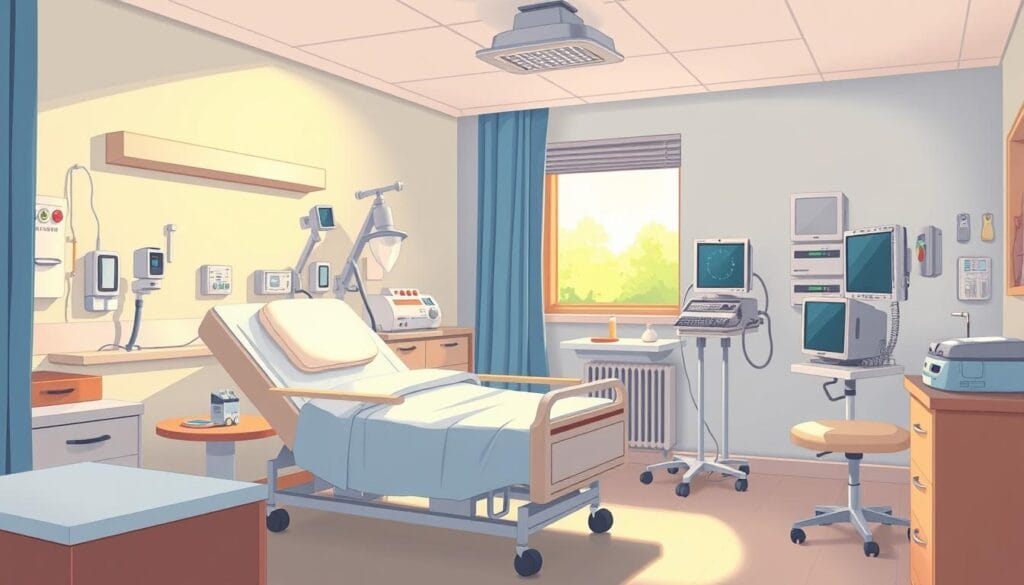
Choosing ECT is a big decision. It's important to talk openly with your doctor about your worries and hopes. With the right help and support, ECT can change lives for those with severe mental health problems.
Electroconvulsive Therapy For Depression
Electroconvulsive therapy (ECT) is a top choice for treating severe, hard-to-treat depression. It greatly improves mood, thinking, and life quality for those with depression. In fact, it works for 70% to 90% of patients, making it a strong ally against depression.
Effectiveness of ECT for Depression
ECT has been around for over 80 years to treat mental health issues, including depression. It induces a controlled brain seizure to reset brain paths and ease depression. For those who didn't get better with usual treatments, ECT can be a big help, offering quick and clear improvements.
Potential Side Effects and Risks
Though ECT is safe and effective for depression, it has risks. Side effects might include short-term memory loss, confusion, headaches, and rarely, serious heart or stroke issues. It's key to talk about these risks with your doctor before starting ECT.
Modern ECT, with anesthesia and better tools, has lowered side effect risks. The benefits of ECT often outweigh the risks, especially for those with severe, hard-to-treat depression.
Choosing ECT should be a team decision with a healthcare expert. They can balance the good and bad for each patient. With careful steps and watchful care, ECT can be a safe, effective way to fight depression.
Aftercare and Maintenance
After ECT for depression, it's key to focus on aftercare and maintenance. This helps keep the treatment's benefits going. Right after ECT, patients are watched closely to make sure they're safe and okay. They might feel confused or forget things for a few days, but these side effects usually go away soon.
Follow-up Care
Regular follow-up care is very important for managing depression after ECT. This includes ongoing therapy, managing medications, and check-ups with the healthcare team. They will tell patients not to drive or do things that need focus until they feel better.
Preventing Relapse
- Living a healthy lifestyle, like exercising, eating well, and managing stress, helps keep ECT benefits and prevents relapse.
- Outpatient maintenance ECT might be suggested to keep patients well and stop depression from coming back.
- Studies show that ECT and antidepressant meds together work better to stop relapse than either one alone.
By focusing on ECT aftercare, ECT follow-up care, and ways to prevent relapse after ECT, patients can get the most out of this effective treatment for depression.

Myths and Misconceptions about ECT
Many myths and misconceptions still surround electroconvulsive therapy (ECT). Some believe it's painful or dangerous. Others think it causes permanent brain damage or is only used when all else fails.
But, modern ECT is safe and effective. Research shows it's much safer than general anesthesia in surgery. It has a very low death rate.
Studies prove ECT works well for severe depression. About 50% to 60% of patients find relief. Up to 90% see improvement when treating depression with psychosis.
Some think ECT is a "miracle cure." But, it's not a quick fix. It takes six to 12 treatments to see results. It's a long-term treatment that needs ongoing care.
By clearing up these myths, we can better understand ECT. It's a safe and effective treatment for severe mental health issues.
Deciding on ECT: Weighing Pros and Cons
Choosing to have electroconvulsive therapy (ECT) for depression is tough. It's key to think about the good and bad sides before deciding. ECT works well for severe or hard-to-treat depression, helping up to 90% of people feel better fast.
ECT is a strong treatment that works quickly for those who haven't gotten better with other treatments. About 70 to 90 percent of people with ECT feel a big improvement. It's also safe for pregnant women, teens, and older adults.
But, ECT has some downsides. The main one is short-term memory loss. This usually goes away in 1 to 6 months after treatment ends. Other side effects like headaches, confusion, nausea, and muscle stiffness are rare and usually mild.
Talking to your doctor is crucial when thinking about ECT for depression. They can help you understand the pros and cons of electroconvulsive therapy based on your situation. With their help, you can decide if deciding on ECT is right for you.

Choosing ECT is a personal decision. Make sure to talk to your doctor about your worries and what you want. This way, you can find the best way to take care of your mental health.
Finding a Qualified ECT Provider
When you look for electroconvulsive therapy (ECT) treatment, it's key to find a skilled provider. These can be psychiatrists, neurologists, or other mental health experts. They should have special training and know-how in ECT.
Patients should look for providers who are board-certified and have lots of ECT experience. They should also work in places that are safe and follow the rules.
Choosing the right ECT specialist is very important. They will make a treatment plan just for you. They will also make sure the treatment is safe and works well.
It's important to find someone who explains everything clearly. They should answer your questions and help you through the whole process.
Look for ECT providers who are board-certified and have extensive experience in administering the procedure.
Ensure the healthcare facility where the ECT treatment will be performed is accredited and follows established safety protocols.
Work with an ECT specialist who takes the time to explain the procedure, address your concerns, and develop a personalized treatment plan.
By finding a qualified ECT provider, you can have a better chance of a successful treatment. This can really help your mental health and improve your life. Remember, your health is the most important thing. So, take your time to find the right ECT specialist for you.
Conclusion
Electroconvulsive therapy (ECT) is a very effective treatment for severe depression and other mental health issues. It may have some risks and side effects. But, it is safe and well-proven when done by experts like Dr. Chandril Chugh.
Knowing the benefits, how it works, and the precautions helps patients decide if ECT is right for them. With the help of skilled doctors, patients can try this therapy. This can lead to better mental health and a better life.
Studies show ECT is very effective, especially when used with psychotherapy. It's better than other treatments like repetitive transcranial magnetic stimulation. It can also work well with ketamine to improve results. If you're facing mental health challenges, talk to your doctor about ECT. Think about the good and bad points to see if it's right for you.
FAQ
What is electroconvulsive therapy (ECT)?
ECT is a treatment that uses small electric currents to the brain. It triggers a brief seizure. This helps with severe mental health issues, like depression.
When is ECT recommended?
Doctors use ECT for severe depression that doesn't get better with other treatments. It's also for bipolar disorder, schizoaffective disorder, and catatonia.
How does ECT work?
First, patients get anesthesia and a muscle relaxant. Then, electrodes are placed on their head. A brief electric current is given, causing a 30-second seizure.
ECT changes the brain's chemistry and pathways. This leads to better mood and overall health.
What can patients expect during and after ECT?
During ECT, patients are closely watched. They might feel confused or forgetful, but these side effects go away in a few days.
After, they should not drive or do things that need focus until they feel better.
How effective is ECT in treating depression?
ECT is very effective for severe depression, with success rates of 70% to 90%. It improves mood and quality of life for many patients.
What are the potential risks and side effects of ECT?
ECT is safe but has risks. These include memory loss, confusion, headaches, and rare serious problems like heart issues or strokes.
Patients should talk to their doctor about the benefits and risks before ECT.
How can patients find a qualified ECT provider?
Finding a good ECT provider is key. Look for a psychiatrist, neurologist, or mental health expert with ECT training.
Choose someone who is board-certified and has lots of ECT experience. They should work in a safe, accredited place.
Source Links
- Content Posted in 2021 | Providence St. Joseph Health Digital Commons
- NeuroPhytomedicine 9781032485935, 9781032485959, 9781003389781 - DOKUMEN.PUB
- Traumatic Brain Injury Treatment | Dr. Chandril Chugh
Depression Symptoms in Men: A Complete Overview | Dr. Chandril Chugh
Depression is a serious mental health issue that affects many people. It can change how someone feels and lives their life. Dr. Chandril Chugh explains how depression shows up differently in men and women. He talks about the challenges men face and the ways to help them.
Depression looks different in men and women. Women often feel sad and worthless. Men might feel tired, angry, or turn to drugs. It's important to know these signs to help them early.
Men also face special challenges because of what society expects. They might think they can't show weakness. Knowing these issues helps us support men better and fight the stigma of depression.
Understanding Depression in Men
Depression in men is often overlooked or misunderstood. This is because of the male depression stigma and how society views men's mental health. Many men feel they must be strong, stoic, and not show emotions. This makes it hard for them to ask for help or talk about their depression.
Unique Challenges for Men
Men with depression face special challenges. They might struggle to share their feelings, worry about being seen as weak, and lack strong support. These issues can make depression worse and make it harder to get better. It's important to understand these challenges to help men with their mental health.

Stigma and Societal Expectations
The idea that men should be tough and not show emotions is a big problem. This stigma stops men from getting help, leading to worse mental health issues. We need to change these harmful ideas and encourage men to talk about their feelings. This will help create a more supportive and welcoming place for everyone.
Physical Symptoms of Depression in Men
Depression in men can show up in many ways, not just in how they feel. It can also affect their body. Signs like constant tiredness, pain, and stomach problems are real and serious. It's important to notice these signs to help men get better.
Fatigue and Sleep Disturbances
Men with depression often feel very tired. They might feel exhausted even after sleeping a lot. Problems sleeping, like not being able to sleep or sleeping too much, are also signs.
These sleep issues make it hard to stay awake and do daily tasks. It's a big challenge for those dealing with depression.
Pain and Digestive Issues
Depression can also cause physical pain and stomach problems. Men might feel pain without a clear reason or have headaches and cramps. Changes in appetite, feeling sick to their stomach, or having trouble going to the bathroom are common too.
These symptoms can really affect a man's life. They shouldn't be ignored because they can make a big difference in how well someone feels.

It's key to recognize the physical signs of depression in men. This way, they can get the right help sooner. Doctors can treat both the emotional and physical parts of depression. This helps men get better in a more complete way.
Emotional and Behavioral Signs
Depression can show up in many ways, not just physical symptoms. It can also change how men feel and act. Knowing these signs is key to spotting depression and getting help.
Men with depression might feel sad, angry, or irritable. They might stop enjoying things they used to love. They could also pull away from friends and family.
They might take more risks, like driving too fast or using drugs. This is another sign of depression in men.
Men often hide their emotional signs, focusing on physical problems instead. This makes it hard for doctors to see the depression.
Depression affects everyone differently. Men might handle it in ways that are unique to them. Getting help from a professional is crucial for the right diagnosis and treatment.
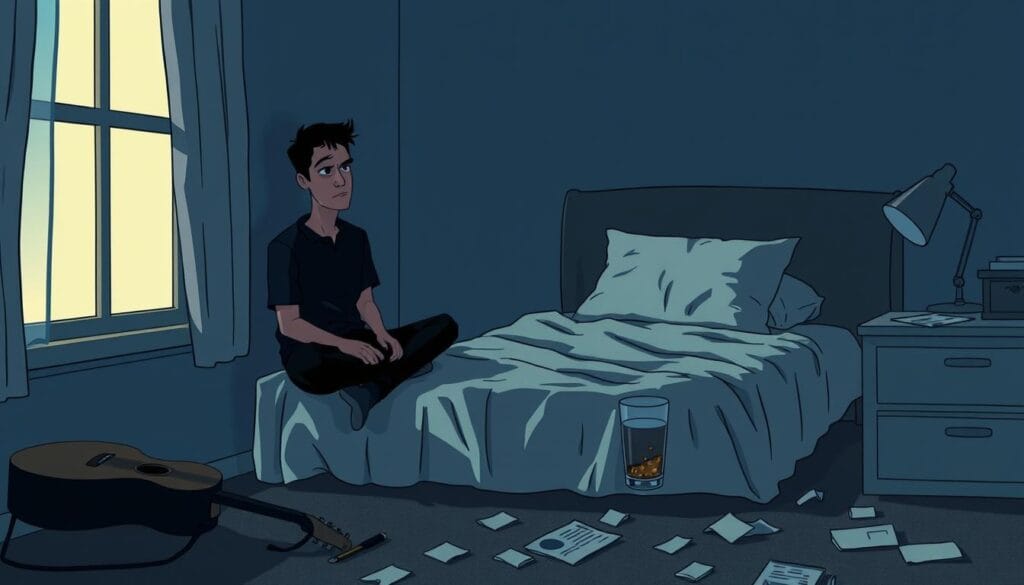
Risk Factors for Depression in Men
Depression can affect anyone, but some factors make men more likely to get it. Knowing these factors helps us spot men at risk. We can then offer them the support and help they need.
Age and Life Transitions
As men get older, they go through big changes. Losing a job or facing a major life change can be tough. These events can make men feel uncertain and lost, raising their risk of depression.
Substance Abuse and Addiction
Using substances can increase a man's risk of depression. Some men might use drugs or alcohol to cope with their feelings. But this can make things worse. It's important to treat both the addiction and depression together.
Knowing these risk factors is key to helping men with depression. By understanding the challenges men face, we can offer better support. This can help reduce depression and improve their overall health.

The Impact of Untreated Depression
Untreated depression in men can cause big problems. It can hurt personal relationships and work-life balance. It can also lead to other mental health issues like anxiety or substance abuse.
Relationship and Work-Life Challenges
Depression can harm a man's personal and work life. It can make relationships with loved ones and colleagues tough. Depression can make a man feel distant, irritable, and hard to talk to.
At work, depression can make it hard to be productive and focused. It can also make it hard to do his job well.
Co-occurring Mental Health Conditions
Men with untreated depression are more likely to get other mental health issues. This includes anxiety disorders or substance abuse problems. These issues can make depression symptoms worse and harder to manage.
It's important for men to seek help for depression. This can help them keep a healthy and happy life. By addressing depression, men can improve their relationships, work-life balance, and mental health.
Seeking Help and Breaking the Stigma
Getting help for depression in men is hard because of the stigma. But, it's key for men to fight this stigma and care for their minds. By sharing their stories, men can help change the way society views mental health.
Healthcare, support groups, and community resources are crucial. They help men find the help they need and learn to manage their depression. It's vital to break the stigma so men feel okay asking for help and can get better.
It's important to teach people about mental health and start open talks. Joining groups like NAMI can help. It gives men a safe place to talk and find support.
Getting treatment can find the root of depression and make life better. Therapists and doctors offer proven ways to help. They provide a safe space for men to talk about their mental health.
By speaking up and taking action, men can get better and help others too. This makes society more supportive and understanding for everyone with mental health issues.
Treatment Options for Men with Depression
Dealing with depression can feel overwhelming. But, there are many ways to get help. Therapy and counseling, like cognitive-behavioral therapy (CBT), can help you understand and change negative thoughts and behaviors. Medication, when given by a doctor, can also help manage your symptoms.
There are also holistic ways to help you feel better. Doing regular exercise, practicing mindfulness, and making healthy lifestyle changes can boost your mood and mental health. By trying different treatments, you can find what works best for you.
Therapy and Counseling
Talking therapies, like CBT, can help you see and change negative thought patterns and behaviors. A therapist or counselor can offer a safe place to talk about your feelings. They can help you learn new ways to cope and become stronger.
Medication and Holistic Approaches
Antidepressant medications, given by a doctor, can help balance your brain's chemicals. Holistic methods, like yoga, meditation, and eating better, can also help. These can make your treatment plan even stronger.
There's no single way to treat depression. By working with your healthcare team, you can find the best treatments for you. This way, you can take charge of your mental health and feel better again.
Conclusion
Depression is a complex issue that affects many men. It can change their lives in big ways. We need to understand the symptoms, risks, and challenges men face with depression.
By working together, we can help men feel less ashamed about their struggles. We can offer better support and resources. This way, men can focus on their mental health and get the help they need.
With more awareness and understanding, we can create a supportive space for men with depression. This can help them get the care they deserve. By tackling depression in men, we can reduce the number of suicides in the U.S. each year.
It's important to remember that depression is treatable. With the right support, men can overcome their mental health challenges. By prioritizing mental health and seeking help, men can improve their lives and find happiness.
FAQ
What are the unique depression symptoms that men may experience?
Men with depression often feel very tired and have trouble sleeping. They might also feel pain or have stomach problems without a clear reason. They might feel sad, angry, or just not care about things they used to enjoy.
How does societal stigma and gender-based expectations impact depression in men?
Men are often expected to be tough and not show emotions. This makes it hard for them to talk about their feelings or get help. The shame around mental health can stop men from seeking the help they need.
What are some of the risk factors that contribute to depression in men?
Depression in men can be linked to getting older and big life changes. It can also be caused by using too much alcohol or drugs. Knowing these risks helps find men who might need help and support.
What are the potential consequences of untreated depression in men?
Depression left untreated can hurt relationships and work life. It can also lead to other mental health problems. It can really affect a man's life, health, and success.
What are the treatment options available for men struggling with depression?
Men with depression have many ways to get better. They can try therapy, like CBT, or take medicine. They can also try exercise, mindfulness, and changing their lifestyle. Finding the right treatment is important for each man's needs.
Source Links
- Strategies For Managing Mood Swings Effectively | Dr Chandril Chugh
- Common Women's Mental Health Issues: What To Know
- Depression in men: causes, symptoms and treatment
Anxiety vs Depression: Understanding the Key Differences | Dr. Chandril Chugh
Anxiety and depression are common mental health issues. They can greatly affect how you feel and what you can do every day. Many people don't get the help they need because of shame, not knowing enough, and not enough resources.
This article, by Dr. Chandril Chugh, a neurologist in the US, aims to explain the main differences between anxiety and depression. It covers their symptoms, what can trigger them, and how they are connected. The goal is to help people get the right help early and improve their mental health.
Unraveling the Basics: What is Anxiety and Depression?
Anxiety: The Persistent Worry
Anxiety makes you feel worried, scared, and uneasy. It happens when you think there's danger. You might feel your heart beat fast, sweat, and feel restless.
It also makes your mind go round and round with worries. Anxiety can really hold you back in life and make you feel bad.
Depression: The Lingering Sadness
Depression is feeling sad all the time and not wanting to do anything. You might sleep too much or too little, eat less, or feel guilty. It's a big problem worldwide, affecting many people.
Anxiety and depression can happen together. This is more common than we thought. Knowing how each one affects you helps find the right way to help.
It's important to talk to mental health experts. They can find out why you're feeling this way. Then, they can help you with therapy, support groups, or medicine.
By facing both anxiety and depression, you take control of your mental health. This is a big step towards feeling better.
The Intricate Relationship Between Anxiety and Depression
Anxiety and depression often go together. Research shows that nearly half of those with major depression also have severe anxiety. This makes it hard to diagnose and treat them well.
Both anxiety and depression can mess with sleep, sex drive, and energy. They share a common thread: negative thoughts. People with anxiety have scary fears and irrational thoughts, leading to depression.
Those with post-traumatic stress disorder (PTSD) are more likely to get depression. The lasting effects of trauma can cause both anxiety and depression. Cognitive Behavioral Therapy (CBT) helps manage these by changing negative thoughts.
Antidepressants, like SSRIs, are often used for both anxiety and depression. Lifestyle changes like exercise and relaxation also help. Avoiding harmful substances is key too.
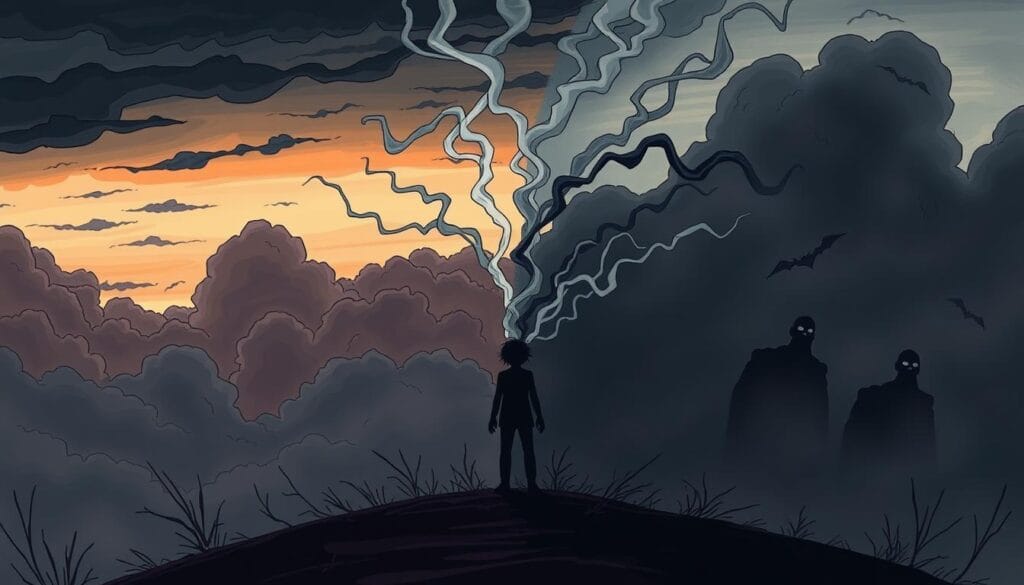
Researchers keep studying the link between anxiety and depression. A complete approach is needed for lasting mental health improvement. Understanding this complex relationship helps people take steps towards healing.
Negative Thought Patterns: The Common Thread
Understanding anxiety and depression often starts with negative thought patterns. These patterns can make you worry a lot or feel sad for a long time. They are a common link between the two conditions.
Perceived Threats and Worthlessness
Anxiety often makes you think about dangers that might not exist. Your mind might imagine terrible things happening. On the other hand, depression makes you feel like you're not worth anything or that things will never get better.
These thoughts can make each other worse, creating a cycle. It's important to recognize and change these negative thoughts to feel better.
Cognitive-Behavioral Therapy (CBT) is a great way to deal with these thoughts. It helps you see your thoughts more clearly and change them for the better.
CBT teaches you to watch your thoughts, change them, and try new things. With time and effort, you can start to feel better and live a more fulfilling life.
Triggers and Risk Factors
Understanding anxiety and depression means knowing what can trigger them. Stressful events like trauma or big life changes can start these conditions. Events like divorce or losing a loved one can raise the risk.
Some things make you more likely to get anxious or depressed. A family history of these issues can play a part. Childhood troubles like abuse or neglect can also make you more vulnerable later on.
- Anxiety disorders can start in childhood or teen years and last into adulthood.
- Examples of anxiety disorders include generalized anxiety disorder, social anxiety disorder, specific phobias, and separation anxiety disorder.
- It is possible to have more than one anxiety disorder simultaneously.
- Agoraphobia is an anxiety disorder where individuals fear and avoid situations that could lead to panic or feeling trapped.
- Panic disorder involves sudden intense feelings of anxiety that peak within minutes, leading to symptoms like chest pain or shortness of breath.
- Social anxiety disorder is characterized by high levels of anxiety, fear, and avoidance of social situations due to concerns about judgment by others.
- Substance-induced anxiety disorder results from the misuse of drugs or exposure to toxic substances.
Trauma or seeing traumatic events can also raise the risk of anxiety disorders. Stress from illness or big life events can cause too much anxiety. Knowing these triggers and risk factors is key to early help and managing anxiety and depression.
Neurochemical Connections
Anxiety and depression have deep connections at the neurochemical level. Imbalances in key neurotransmitters like serotonin, norepinephrine, and dopamine play a big role. This is why understanding these factors is key for doctors to find the right treatments.
Studies show that people with anxiety and depression have different levels of neurotransmitters in their brains. For instance, serotonin levels are often lower in both conditions. Norepinephrine and dopamine imbalances also play a part. These imbalances mess with emotions, thinking, and body responses, making symptoms worse.
The link between neurotransmitters and these conditions is complex. It's not just one neurotransmitter causing the problem. The way different neurotransmitters work together affects anxiety and depression. By studying these connections, doctors can create better treatments for each person.
In short, looking into the neurochemical side of anxiety and depression is very important. Knowing how neurotransmitters like serotonin, norepinephrine, and dopamine work helps doctors find better ways to treat these conditions.
Anxiety vs Depression: Recognizing the Signs
It's key to know the signs of anxiety and depression to get help fast. [https://www.bannerhealth.com/healthcareblog/better-me/do-i-have-anxiety-depression-or-both-here-is-how-to-tell]Anxiety shows as constant worry, feeling restless, and physical signs like a fast heart rate. Depression is about feeling sad all the time, losing interest in things, and changes in sleep and eating.
Anxiety Symptoms
- Persistent, excessive worry or fear
- Feeling restless or on edge
- Irritability and difficulty concentrating
- Physical symptoms like rapid heartbeat, sweating, and muscle tension
Depression Symptoms
- Persistent feelings of sadness, hopelessness, or emptiness
- Loss of interest or pleasure in activities you once enjoyed
- Changes in sleep patterns, such as difficulty falling asleep or oversleeping
- Significant weight loss or gain, or changes in appetite
- Feelings of guilt, worthlessness, or excessive self-criticism
- Difficulty concentrating or making decisions
- Recurrent thoughts of death or suicide
Spotting these signs is the first step to getting help and finding ways to cope. [https://www.bannerhealth.com/healthcareblog/better-me/do-i-have-anxiety-depression-or-both-here-is-how-to-tell]If you're feeling anxious or depressed a lot, talk to a mental health expert. They can help figure out what's going on and what to do next.

Seeking Professional Help: The Crucial Step
Managing anxiety and depression needs professional help. Doctors, like psychiatrists and psychologists, can help. They give the right diagnosis and treatment plan. They also guide you through the recovery process.
It's important to see a mental health expert. They offer many benefits. This includes getting the right treatment and emotional support.
- Accurate diagnosis and personalized treatment recommendations
- Emotional support and guidance throughout the recovery journey
- Preventive interventions to manage the underlying causes of anxiety and depression
- Strategies to develop healthy coping mechanisms and improve overall mental health
Reaching out to mental health experts is a big step. It's the first step in seeking help for anxiety and depression. By doing this, you can get the professional help for mental health you need.
Remember, asking for help is brave. It's not a sign of weakness. It's a step towards better mental health and a happier life.
Integrated Approaches to Treatment
Managing anxiety and depression well needs a mix of treatments. This mix helps lessen symptoms, balance brain chemicals, and teach coping skills.
Medication Management
Doctors can prescribe medicines that help with anxiety and depression. These drugs balance brain chemicals, improving mood and reducing symptoms. It's key to talk often with your doctor to find the right medicine for you.
Psychotherapy Interventions
Psychotherapy, like CBT and DBT, is very helpful. It helps people face and change bad thoughts, learn coping skills, and better manage emotions.
Support Groups and Lifestyle Modifications
- Support groups offer a community, compassion, and shared experiences. They are very helpful in recovery.
- Changing your lifestyle, like eating well, exercising, and managing stress, also helps your mental health.
The best way to handle anxiety and depression is with a mix of medicines, therapy, and lifestyle changes. Each person's needs are different, so a custom plan works best.
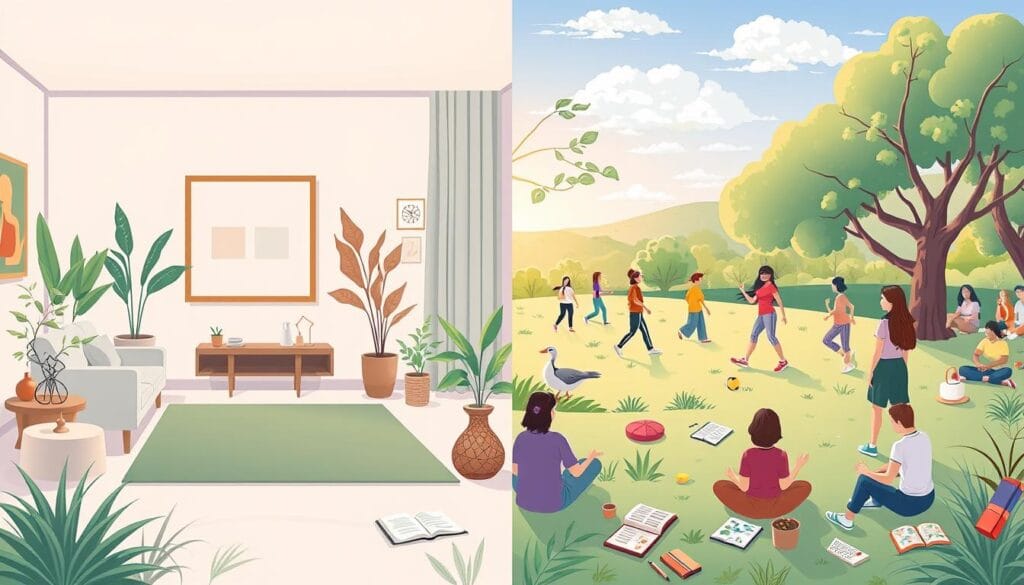
Combating Stigma and Raising Awareness
It's important to fight the stigma around mental illness. Many people still have negative views about those with mental health issues. [Alonso et al. (2008) found that perceived stigma is associated with mood and anxiety disorders, as revealed in the World Mental Health Surveys.] This stigma can make people not want to get help, feel misunderstood, and struggle in school or work.
Getting help for mental illness is key. It can help find and fix problems that affect daily life. [Schnyder et al. (2017) conducted a systematic review and meta-analysis, which revealed an association between mental health-related stigma and active help-seeking behavior.] Talking to others who understand, joining groups, and finding support are good steps.
Speaking out against stigma and educating others can help. Many people don't understand mental illness because they lack information. By accepting our conditions and educating others, we can fight the stigma around mental health.
Stigma can make it hard for people to get help. It can make them feel hopeless and ashamed. Stigma affects how people see themselves and how others see them, even after they've gotten help.
To fight stigma, we can learn about mental illness and substance use disorders. We should think about our own attitudes and words. We can support and encourage others and advocate for fairness. By being supportive, we can help people get the help they need sooner and improve their mental health.
Conclusion: Hope for Healing and Recovery
Anxiety and depression are tough mental health issues. But, with the right help and treatment, you can get better. Knowing the differences, signs, and symptoms is key. Seeking professional help is a big step towards feeling better.
Medicine, therapy, support, and lifestyle changes can help a lot. They give you hope and help you take back control of your life. This way, you can look forward to a brighter future.
Hope is very important for getting better. Studies show it helps a lot with anxiety. It makes symptoms go down and helps you heal for good.
By being optimistic and finding ways to reach your goals, you can use hope to your advantage. It helps you on your way to better mental health.
You're not alone in this fight. Many people worldwide face the same challenges. With the right support, you can beat these obstacles and find your inner strength.
Don't give up. With determination and a focus on your well-being, you can heal and recover. Hold onto hope and start a journey to a happier, more fulfilling life.
FAQ
What are the key differences between anxiety and depression?
Anxiety makes you feel worried and scared all the time. It's like your brain is always on high alert, ready for danger. Depression, however, makes you feel sad and unmotivated. You might lose interest in things you used to love doing.
How are anxiety and depression related?
Anxiety and depression often go hand in hand. If you have one, you're more likely to get the other. This makes it hard to figure out what's going on and how to treat it.
What is the role of negative thought patterns in anxiety and depression?
Both anxiety and depression involve negative thoughts. Anxiety makes you think about dangers all the time. Depression makes you feel like you're not worth anything. These thoughts can make things worse, creating a cycle of sadness and fear.
What are the common triggers and risk factors for anxiety and depression?
Big life changes or scary events can trigger both anxiety and depression. Things like divorce or losing someone close can make you more likely to feel anxious or depressed.
How are anxiety and depression connected at the neurochemical level?
Anxiety and depression share some brain chemistry. They both affect things like serotonin and dopamine. When these chemicals are off, it can lead to feelings of anxiety or sadness.
How can I recognize the signs and symptoms of anxiety and depression?
Anxiety makes you feel worried and on edge. You might get irritable or have physical symptoms like a fast heart rate. Depression makes you feel sad and unmotivated. You might also sleep too much or too little, or lose your appetite.
Why is seeking professional help important for managing anxiety and depression?
Getting help from a doctor or therapist is key. They can help figure out what's going on and come up with a plan to feel better. They guide you through the process of getting better.
What are the key elements of an effective treatment approach for anxiety and depression?
Good treatment for anxiety and depression combines a few things. It might include medicine, talking therapy, support groups, and making healthy lifestyle choices. Finding the right mix for you is important.
How can we reduce the social stigma associated with anxiety and depression?
We need to talk more about mental health to reduce stigma. By sharing what we know about anxiety and depression, we can help people feel more comfortable seeking help. This can lead to more people getting the support they need.
Source Links
- Understand Difference Between Anxiety And Depression
- Content Posted in 2021 | Providence St. Joseph Health Digital Commons
- 10 Things Everyone Should Understand About Depression
- What It REALLY Means If You've Been Diagnosed With Anxiety or Depression
- Is It Anxiety or Depression? How to Tell the Difference - GoodTherapy.org Therapy Blog
Alternative Therapies for Depression: Holistic Approaches | Dr. Chandril Chugh
Depression is a big problem worldwide, affecting millions. While meds are common, more people are looking at natural ways to feel better. Dr. Chandril Chugh leads the way in this shift, showing how natural remedies can help.
Diet changes and omega-3 fatty acids can make a big difference. Yoga, mindfulness, and herbal supplements also help. This article aims to teach you about these options, helping you feel better and regain your joy.
Dr. Chugh's insights will guide you on a path to better mental health. Whether you want to add to your current treatment or try something new, this article will help. It's all about taking charge of your mental health and feeling better.
Understanding Depression and Its Impact
Depression is a complex mental health issue that affects many people. It's more than just feeling sad. It deeply affects a person's thoughts, feelings, and overall health. Knowing the symptoms and causes of depression is key to managing it well.
Symptoms and Causes of Depression
Depression symptoms include feeling sad, hopeless, and losing interest in things. It can also cause fatigue, sleep and appetite changes, and trouble concentrating. Some people even think about suicide. The exact reasons for depression are still being studied. But, it seems genetics, biology, and environment play a role.
The Importance of Holistic Approaches
- Traditional treatments like medicines and therapy work, but they miss the mind-body link.
- Holistic methods focus on the whole person - body, mind, and spirit.
- Therapies like mindfulness, yoga, and herbal remedies can help alongside traditional treatments.
Understanding depression and using holistic methods can help people manage their mental health better. This way, they can find lasting relief from depression's effects.
Dietary and Nutritional Remedies
Diet and nutrition are key in fighting depression. Adding certain nutrients to your day can help a lot. Let's look at some foods that might help with depression.
Omega-3 Fatty Acids and Their Benefits
Omega-3s are in fatty fish, walnuts, and flaxseeds. Research shows they're good for our brains. Eating more of these foods might make you feel better and less sad.
Probiotic-Rich Foods for Gut Health
Our gut health affects our mood. Foods like yogurt and sauerkraut have good bacteria. They can help make you feel happier and less depressed.

Eating right can help with depression. The right foods can boost your mood and energy. A healthy diet is key to feeling better.
Alternative therapies for depression
If you're looking for new ways to deal with depression, you're in luck. There are many natural remedies and therapies to try. These options can help alongside traditional medicine or as a standalone choice.
Some promising alternative therapies for depression include:
- Omega-3 fatty acids, which can boost mood and reduce brain inflammation
- Probiotic-rich foods, which support gut health and might help your mood
- Mindfulness and meditation, which can lower stress and improve emotional balance
- Yoga, focusing on breath, movement, and relaxation
- Herbal remedies like St. John's wort, studied for mild to moderate depression relief
- Light therapy, helping to regulate your body's clock and mood
- Acupuncture, a traditional Chinese medicine that might help with depression
Remember, how well these therapies work can vary. Always talk to a healthcare expert before adding them to your treatment. By trying different natural remedies, you can find what works best for you.

Mindfulness and Meditation Practices
If you're struggling with depression, adding mindfulness and meditation to your routine can change your life. Many studies show these methods help with depression and anxiety. They make a big difference in mental health.
Mindfulness-based therapies like MBCT and MBSR can lower the chance of depression coming back. They help control emotions and bring calm. These are key in fighting depression.
Meditation also offers many benefits. It can boost your immune system and help you recover faster. It also makes you think less negatively and feel better emotionally. This is great for those with depression.
- A 2015 study showed mindfulness helps improve mental health and wellbeing.
- Since 1982, mindfulness meditation has helped chronic pain patients.
- Mindfulness-based cognitive therapy was introduced in 2002 to prevent depression relapse.
Adding mindfulness and meditation to your day can help with depression. They teach you to be present, kind to yourself, and manage emotions. This makes dealing with depression easier.

Yoga and Its Role in Mental Well-being
Yoga is a powerful tool for managing depression. It combines physical postures, breathing exercises, and mindfulness. This helps both your body and mind.
Adding yoga to your routine can bring big benefits. It can help you feel better and find relief from depression.
Pranayama and Breathing Exercises
Pranayama is the art of controlled breathing in yoga. It deeply affects your mental health. These exercises calm your mind, reduce stress, and help you relax.
Practices like Ujjayi, Nadi Shodhana, and Bhramari Pranayama help with depression and anxiety. They are great for your self-care.
Yoga Poses for Stress Relief
Some yoga poses are great for stress relief. Child's Pose, Corpse Pose, and Reclined Bound Angle Pose help release tension. They make you feel calm.
Backbends like Camel Pose and forward folds like Standing Forward Fold balance your emotions. They help you feel grounded.
Yoga can change your life. It helps with depression and improves your mental health. Yoga is a powerful ally on your journey to wellness.

Herbal Remedies and Supplements
Many people are looking into alternative ways to manage depression. They are trying herbal remedies and supplements. St. John's Wort is a plant-based supplement that some use for depression.
St. John's Wort and Its Potential Benefits
A 2016 study found St. John's Wort helps with mild to moderate depression. It was as good as some prescription drugs. But, it's not FDA-approved in the U.S. for depression. It can also interact with other medicines.
Other herbal remedies and supplements are being studied for depression. These include omega-3 fatty acids, probiotics, saffron, and SAMe. Some studies show they might help, but more research is needed.
Always talk to your doctor before trying new herbal or supplement products. They can help with dosage and any possible side effects.
Light Therapy and Its Applications
If you're fighting depression, light therapy might help. It's also called phototherapy. This method has shown to work well for depression, including SAD.
Light therapy uses bright, artificial light like sunlight. It helps the body's clock and brain chemicals. This can make depression symptoms better. In fact, it's as good as some meds for SAD, but works faster.
Choosing the right light therapy box is key. It should be very bright (around 10,000 lux) but not have UV rays. Use it for 20-30 minutes right after waking up. Keep it 16-24 inches from your face.
- Light therapy boxes for SAD treatment should deliver a therapeutic dose of 10,000 lux of bright light.
- The light boxes should filter out most or all UV light to avoid eye damage.
- Typically, light therapy should be used for 20-30 minutes within the first hour of waking up in the morning.
- The light box should be placed 16-24 inches away from the face for optimal results.
Light therapy is usually safe, but talk to your doctor first. Especially if you have eye problems or take certain meds. With the right advice, light therapy can be a great tool against depression.
Acupuncture and Traditional Chinese Medicine
Looking into alternative therapies for depression? Acupuncture and traditional Chinese medicine (TCM) are interesting options. Acupuncture, a key part of TCM, is getting more attention for helping with depression.
Acupuncture is an old Chinese method. It uses thin needles in certain body spots to move "qi" (vital energy). Studies say it might help depression by changing brain chemicals, reducing inflammation, and affecting the body's stress system.
- More than 10 million acupuncture treatments are given each year in the U.S.
- Between 19% to 34% of people with depression don't get better with meds or therapy.
- About 15% to 50% of people with depression get it again, even with treatment.
TCM views depression as a lack of "vital energy" due to body system problems. TCM herbal mixes, made from plants, have shown to help with depression. They work on different depression pathways.
Acupuncture and TCM might help with depression. But, it's key to see a certified practitioner for safe and right treatment. Trying these ancient methods with modern therapies could help you find a treatment that works for you.
Conclusion
This article looked at different ways to handle depression, beyond just medicine. We talked about how food, mindfulness, yoga, and herbal remedies can help. We also mentioned light therapy and traditional Chinese medicine like acupuncture.
Even though studies on these alternative depression therapies show mixed results, they can still be helpful. It's key to work with doctors to mix these methods with traditional treatments. This way, you can find what works best for you.
Remember, there's no single way to improve your mental health. Try out the holistic treatments we discussed. Experiment with different therapies to find what suits you best. By using a whole approach, you can manage your depression and live a better life.
FAQ
What is the focus of this article?
This article talks about new ways to fight depression. Dr. Chandril Chugh, a neurologist in India, leads the way. It looks at natural remedies and other treatments for depression.
Why is a holistic approach to managing depression important?
A holistic approach is key for managing depression. It goes beyond just medicine. It looks at the mind-body connection and aims to fix the root causes of depression.
How can dietary and nutritional factors help with depression?
Diet and nutrition play a big role in fighting depression. Omega-3 fatty acids and probiotics are good for the mind. They help alongside traditional treatments.
What are some of the alternative therapies explored in the article?
The article talks about many alternative therapies for depression. These include mindfulness, meditation, yoga, herbal remedies, and more.
How can mindfulness and meditation help with depression?
Mindfulness and meditation are great for depression. They help control emotions and reduce stress. They work well with other treatments.
What are the benefits of incorporating yoga into a holistic approach to managing depression?
Yoga is good for depression. It includes breathing exercises and poses. These help reduce stress and improve mental health.
What is the potential role of herbal remedies and supplements in managing depression?
Herbal remedies and supplements might help with depression. St. John's Wort is one example. It's been studied for its benefits.
How can light therapy be used as an alternative approach to addressing depression?
Light therapy is another option for depression. It involves using light to help the body's natural rhythms. It has scientific backing and practical uses.
What is the role of acupuncture and traditional Chinese medicine in the holistic management of depression?
Acupuncture and traditional Chinese medicine are also options. They have ancient roots and can help with mental health. They focus on the body's energy.
Source Links
- Find Effective Natural Remedies For Anxiety | Dr Chandril
- Music Therapy For Depression: How It Can Help
- 6 Uses and Advantages of CBD Oil with Side Effects
- Depression (major depressive disorder) - Diagnosis and treatment
Manic Depression in Men: Signs and Treatment Options | Dr. Chandril Chugh
Manic depression, also known as bipolar disorder, affects men deeply. It causes big mood swings. Men can feel very high and then very low.
While it hits both men and women, men's symptoms can be different. They need special care.
Dr. Chandril Chugh, a mental health expert, will talk about manic depression in men. He will cover signs, symptoms, and treatment options. This info can help you or a loved one with manic depression.
Understanding Manic Depression in Men
Manic depression, also known as bipolar disorder, is a complex mental health condition. It causes significant mood swings in individuals. Men with bipolar disorder can feel very energized and happy during mania. Then, they can feel very sad and tired during depression.
These mood swings can greatly affect a man's daily life and relationships. They can also impact his overall well-being.
What is Manic Depression?
Manic depression, or bipolar disorder, is a chronic condition. It involves alternating periods of mania and depression. During mania, a person feels very upbeat and full of energy.
Depressive episodes are marked by sadness, loss of interest, and feelings of worthlessness. The types of bipolar disorder vary in severity and duration of mood swings.
Symptoms of Manic and Depressive Episodes
Symptoms of manic episodes in men with bipolar disorder include:
- Increased energy, activity, and restlessness
- Heightened mood, feeling "on top of the world"
- Reduced need for sleep
- Racing thoughts and rapid speech
- Impulsive or risky behavior
Symptoms of depressive episodes may include:
- Persistent feelings of sadness, hopelessness, and emptiness
- Loss of interest in previously enjoyable activities
- Changes in appetite and sleep patterns
- Fatigue and lack of energy
- Difficulty concentrating and making decisions
- Feelings of worthlessness and guilt
- Recurrent thoughts of death or suicide
Understanding the types of bipolar disorder is crucial. It helps in managing and treating the condition effectively.
Prevalence and Impact of Manic Depression on Men
Manic depression, also known as bipolar disorder, affects about 2.8% of adults in the U.S. It impacts both men and women, but seems more common in men.
Men with manic depression face big challenges. They might struggle to keep a job, build lasting relationships, and take care of their health. High mood and energy in manic episodes can mess up their life. Sadness and fatigue in depressive episodes make things worse.
Studies show that 82.9% of people with bipolar disorder had moderate to serious problems last year. Also, 17.1% had moderate issues. In the U.S., 2.9% of teens aged 13-18 have bipolar disorder, with 2.6% severely affected.
It's key to spot manic depression early and treat it well. This way, men can get their lives back on track. They can improve their relationships and succeed in work and personal life.
Causes and Risk Factors of Manic Depression in Men
The exact causes of manic depression, also known as bipolar disorder, are not fully understood. Research suggests that both biological and genetic factors, and environmental and lifestyle factors, may contribute to it in men.
Biological and Genetic Factors
Imbalances in brain chemicals, like serotonin, dopamine, and norepinephrine, are linked to manic depression. Neurological differences in the brain's structure and function may also play a role. Genetic factors are important, as the condition is more common in those with a family history of bipolar disorder.
Environmental and Lifestyle Factors
Stressful life events, like trauma or major life changes, can increase the risk of manic depression in men. Substance abuse, certain medical conditions, and sleep disruptions may also contribute to the onset of the disorder.

Understanding the causes of manic depression is complex. It often involves a mix of these factors. Knowing the unique risk factors helps men and their healthcare providers create a good treatment plan.
Manic depression in men
Manic depression, or bipolar disorder, shows up differently in men than in women. It's important to know the signs of manic and depressive episodes. This helps in treating the condition early and effectively.
Recognizing the Signs of Manic Episodes in Men
Men with bipolar disorder act differently during manic episodes. They feel more energetic and restless. They might also act impulsively or recklessly.
They could think they're more important than they are. They might not need to sleep much and talk a lot. They might even take risks, like spending too much money or being too risky in their relationships.
Identifying the Symptoms of Depressive Episodes in Men
Depressive episodes in men with bipolar disorder are different. They feel sad, hopeless, and worthless. They might not want to do things they used to enjoy.
They could also sleep too much or too little, eat less, or have trouble focusing. Sadly, they might even think about suicide during these times.
It's key to recognize these symptoms to get help quickly. Understanding these challenges helps us improve mental health for men with bipolar disorder.

Diagnosing Manic Depression in Men
Diagnosing manic depression, or bipolar disorder, in men is complex. Doctors like psychiatrists or psychologists use interviews, medical history, and special tools to diagnose. They also check for other health issues that might cause symptoms.
The DSM-5 outlines the criteria for diagnosing manic depression. It includes both manic and depressive episodes. Men with bipolar disorder may show symptoms differently than women. It's key for doctors to know these differences.
Key Steps in Diagnosing Manic Depression in Men
- Clinical Interview: Doctors will talk in-depth to understand symptoms, mood, and daily life impact.
- Medical History: Reviewing past health and treatments is crucial to rule out other causes.
- Standardized Assessment Tools: Doctors use mood questionnaires or scales to measure symptoms.
- Physical Examination: A physical check-up is done to find any underlying health issues.
- Laboratory Tests: Blood tests or other tests may be done to check for medical causes.
Doctors use a detailed approach to diagnose manic depression in men. This ensures an accurate diagnosis and a proper treatment plan. Early and accurate diagnosis is vital for managing this complex condition.

Treatment Options for Manic Depression in Men
Men with manic depression, also known as bipolar disorder, get help in many ways. They use medicines and talk therapy. The goal is to control the ups and downs of the condition and help them feel better over time.
Medication Management
Medicines are key in treating manic depression in men. They might take mood stabilizers like lithium or anticonvulsants. They might also take antidepressants and antipsychotics. These medicines work together to manage the condition's different phases.
- Mood stabilizers like lithium, valproic acid, and lamotrigine help control mood swings and prevent relapse.
- Antidepressants are used carefully, often with a mood stabilizer or antipsychotic, to treat depression.
- Antipsychotics such as quetiapine, risperidone, and lurasidone help with manic episodes.
Psychotherapy and Counseling
Psychotherapy and counseling are also important. They help men with manic depression learn to cope better. They improve emotional control and overall well-being.
- Cognitive-behavioral therapy (CBT) helps men change negative thoughts and behaviors.
- Interpersonal therapy improves relationships and communication, which can be affected by mood swings.
- Family therapy helps the individual and their loved ones manage the condition and stay healthy.

Every man with manic depression gets a treatment plan that fits them. This plan might include a team of doctors, psychologists, and therapists. It's important to talk often with the healthcare team to manage symptoms and adjust treatments.
Lifestyle Changes and Self-Care Strategies
Living with manic depression, or bipolar disorder, is tough for men. But, making lifestyle changes and practicing self-care can help a lot. By focusing on your well-being, you can keep your mood stable and improve your life.
Getting enough sleep is key. A regular sleep schedule helps your body stay in rhythm and prevents mood swings. Stress management, like meditation or yoga, also helps handle stress and anxiety.
Eating well and staying active are important too. A healthy diet and regular exercise boost your mood and help with sleep. They also reduce anxiety and depression.
Having a strong support network is vital. Joining a support group or talking to a mental health expert can help. Sharing with loved ones also gives you the support you need.
Managing manic depression needs a mix of medical care, lifestyle changes, and self-care. By focusing on your well-being and using these strategies, you can manage your condition better. This improves your life quality.
Coping with Manic Depression as a Man
Living with manic depression can be tough for men. They often face stigma and high expectations about mental health. It's key to build a strong support system and find ways to cope.
Dealing with Stigma and Societal Expectations
Men with manic depression might feel like they must hide their struggles. But, seeking help is a sign of strength, not weakness. Challenging these expectations can help you feel empowered and improve your mental health.
Building a Support System
Having a network of supportive people can greatly help. This could be through support groups, therapy, or friends and family. A strong support system offers understanding and resources to manage your condition.
Remember, coping with bipolar disorder as a man means tackling unique challenges. With a strong support system and effective coping strategies, you can manage your mental health and live a fulfilling life.
Conclusion
Manic depression, also known as bipolar disorder, is a complex mental health issue. It can greatly affect men's lives. Understanding the signs and symptoms is key.
There are many treatment options and self-care strategies. Men can manage their symptoms and improve their well-being.
Men should seek professional help and build a strong support network. They must also address any societal stigma or expectations.
With the right treatment and support, men can thrive and live fulfilling lives. Remember, you are not alone. There are resources and strategies to help you manage this condition and live your best life.
Manic depression is a summary of manic depression in men. By taking a proactive approach to your mental health, you can overcome the challenges of managing bipolar disorder as a male.
The key takeaways on managing bipolar disorder in males are to seek help, build a support system, and prioritize self-care. With the right support and strategies, you can learn to manage your condition and live a fulfilling life.
FAQ
What is manic depression?
Manic depression, also known as bipolar disorder, is a mental health issue. It causes big mood swings. People can feel very high and full of energy, then very low and tired.
How does manic depression present differently in men?
Manic depression affects both men and women, but differently. Men might find it hard to keep a job or build relationships. They also struggle with their health.
What are the common signs and symptoms of manic and depressive episodes in men with manic depression?
In manic episodes, men feel very energetic and might act impulsively. They might also think they're very important. In depressive episodes, they feel sad, hopeless, and don't enjoy things they used to.
How is manic depression in men diagnosed?
Diagnosing manic depression in men is tricky. Symptoms can look like other mental health issues. Doctors use interviews, medical history, and special tools to figure it out.
What are the treatment options for manic depression in men?
Treatment for manic depression in men includes medicine and therapy. Medicine helps control mood swings. Therapy helps men learn to cope and feel better.
How can men with manic depression manage their condition through lifestyle changes and self-care?
Men with manic depression can feel better by sleeping well, managing stress, eating right, and exercising. Having a strong support system is also key.
How can men with manic depression cope with societal stigma and expectations?
Men with manic depression face stigma and expectations. It's important for them to seek help and support. This helps them deal with their condition and find ways to cope.
Source Links
- Strategies For Managing Mood Swings Effectively | Dr Chandril Chugh
- Best Neurologist In Patna, Author Dr Chandril Chugh
- Bipolar disorder - Symptoms and causes
Best Therapy for Anxiety and Depression: A Comprehensive Guide | Dr. Chandril Chugh
Dealing with anxiety and depression can be tough. But, with the right help, you can feel better. Dr. Chandril Chugh, a well-known neurologist, will guide you. He shares the best ways to handle these common mental health problems.
Anxiety and depression affect many people of all ages and backgrounds. But, many don't talk about it because of shame or not knowing enough. Dr. Chugh's advice can help you take charge of your mental health and start healing.
This guide will show you the strength of therapies like CBT, exposure therapy, and mindfulness. These methods help change how you think, face fears, and understand yourself better. Dr. Chandril Chugh will help you find the therapy that fits you best. This way, you can start feeling better emotionally.
Understanding Anxiety and Depression
Anxiety and depression are common mental health issues. They affect millions of people around the world. These conditions can change how you live, who you connect with, and how you feel about yourself.
Symptoms and Manifestations
Anxiety makes you worry a lot and feel scared. You might also feel like something bad is going to happen. Physical signs include a fast heartbeat, sweating, and tight muscles.
Depression makes you feel sad all the time. You might lose interest in things you used to enjoy. You could also sleep too much or too little, or feel very tired.
Prevalence and Impact
Many people have anxiety or depression. In fact, over 10% of Americans take antidepressants. This is especially true for people between 18 and 44.
These conditions can really affect your life. They can make it hard to do everyday things. But, there are treatments that can help.
Things like therapy and medicine can work well. Changing your lifestyle, like exercising and managing stress, can also help. These steps can improve your mental health.
Knowing about anxiety and depression can help you take care of your mental health. It's important to seek help and support to overcome these challenges.
Cognitive Behavioral Therapy (CBT): The Gold Standard
Cognitive Behavioral Therapy (CBT) is seen as the top choice for treating anxiety and depression. It's based on the cognitive model. This model shows how our thoughts, feelings, and actions are linked together.
The Cognitive Model: Understanding Thought Patterns
The cognitive model says our thoughts greatly affect our feelings and actions. By knowing the thoughts that lead to anxiety and depression, we can change them. We can switch to more positive and helpful ways of thinking.
CBT helps people spot and change negative thought patterns. These patterns include thinking the worst, generalizing too much, and seeing things as all or nothing. Working with a therapist, people learn new ways to handle their problems and feelings.
- CBT is considered the gold-standard psychological treatment due to being the most researched form of psychotherapy.
- CBT dominates international guidelines for psychosocial treatments and is considered a first-line treatment for many disorders.
- CBT is continuously evolving based on research and seen as a progressive research program.
CBT helps people deal with anxiety and depression by focusing on thoughts. It's backed by lots of research and is a trusted treatment. It helps people take charge of their recovery.

Exposure Therapy: Confronting Fears and Anxieties
Exposure therapy is a strong tool for treating anxiety disorders. It involves slowly facing things that make you anxious. This helps you overcome fears and feel more in control.
Studies show exposure therapy works well. People who try it often see their anxiety symptoms drop by up to 90%. It's especially helpful for those with phobias, panic disorder, and more.
There are different ways to do exposure therapy. You might face the real situation, imagine it, use virtual reality, or deal with physical feelings of anxiety. Your therapist will pick the best method for you.
At first, exposure therapy might seem scary. But it's a powerful way to face your fears. By slowly facing your triggers, you can stop avoiding them and find new ways to cope. A skilled therapist will help you on this journey.
Remember, exposure therapy is not the same for everyone. Your progress will be unique. Your therapist will make sure the process is safe and fits your needs. With hard work and dedication, exposure therapy can change your life.
Mindfulness: A Powerful Tool for Self-Awareness
Mindfulness is a powerful practice for managing anxiety and depression. It helps you understand your thoughts, feelings, and actions better. This self-awareness lets you handle stress better and be kinder to yourself.
Studies show mindfulness helps with anxiety and depression. A study by Goyal et al. (2014) found meditation improves stress and well-being. Kabat-Zinn and Massion (1992) also found meditation helps with anxiety disorders.
Mindfulness improves your focus and thinking. Moore and Malinowski (2009) found mindfulness meditation boosts cognitive flexibility and attention. Ortner et al. (2007) showed it helps focus on tasks by reducing emotional distractions.
Adding mindfulness to your mental health journey is beneficial. It helps you understand yourself better and handle life's challenges. Combining it with other therapies like cognitive behavioral therapy can be very effective.
Remember, mindfulness is a personal journey. Try different techniques like meditation, breathing exercises, and mindful walking. Regular practice can greatly improve your mental health and life quality.
Best therapy for anxiety and depression
Finding the right therapy for anxiety and depression is not easy. These conditions are complex and affect people differently. But, many therapies have shown to be very helpful.
Cognitive Behavioral Therapy (CBT) is a top choice. It helps change negative thoughts into positive ones. People often see improvements in just a few weeks.
Exposure Therapy is another effective method. It helps people face their fears slowly. Virtual Reality Exposure Therapy (VRE) is even more advanced and helps with PTSD and phobias.
Mindfulness-based therapies like Acceptance and Commitment Therapy (ACT) and Dialectical Behavioral Therapy (DBT) are also helpful. They teach people to deal with difficult thoughts and feelings better. These therapies promote self-awareness and living a meaningful life.
For those who don't respond to usual treatments, Transcranial Magnetic Stimulation (TMS) is an option. It's safe and non-invasive. Theta Burst Stimulation is a newer, faster version of TMS.
Choosing the right therapy for anxiety and depression is important. Work with a mental health professional to find the best fit for you. This way, you can make a plan that meets your needs and goals.
The Effectiveness of CBT for Anxiety and Depression
Many studies show that cognitive behavioral therapy (CBT) works well for anxiety and depression. It helps people feel better for a long time. This is because CBT changes how people think and act.
A study in the Annual Review of Psychology found CBT's benefits last long after treatment. It helps people handle their feelings on their own. It also stops symptoms from coming back, which is great for keeping well.
Research backs up CBT's success for anxiety and depression. It's better than other treatments, like medicines, in making people feel and function better. This shows CBT is a strong choice for treating these issues.
When CBT is used with medicines, it works even better for severe depression. This shows how well CBT and medicines can work together. CBT helps people manage their thoughts and actions, leading to lasting recovery.
In summary, CBT is a top choice for treating anxiety and depression. It gives people the tools to overcome their problems. This leads to a better life and more happiness.

Medications: A Complementary Approach
Therapy is often the main way to handle anxiety and depression. But, medications can also help. It's key to get advice from a pro before starting any meds.
Types of Medications
Antidepressants, like SSRIs and SNRIs, help with depression. Anti-anxiety meds, like benzodiazepines and buspirone, ease anxiety symptoms.
Importance of Professional Guidance
Getting help from a mental health expert is vital for meds. They tailor advice to your needs and health. They also check how well the meds work and watch for side effects.
The FDA doesn't check most alternative treatments for mental health. The National Center for Complementary and Integrative Health (NCCIH) does. Some studies show these treatments can be safe.
Combining therapy, meds, and lifestyle changes works best for anxiety and depression. With a mental health pro, you can find the best treatment for you.
Lifestyle Modifications: A Holistic Approach
Managing anxiety and depression can be helped by making lifestyle changes. These changes can support your mental health by addressing both mind and body. Let's look at how different lifestyle factors can help.
Exercise is a big help against anxiety and depression. Doing regular physical activities, like aerobic exercises, can make you feel better. Try to exercise for at least 30 minutes, most days of the week.
Good sleep is key for your mental health. Having a regular sleep schedule and a calm sleep area can help. Getting enough sleep lets your body and mind rest, which helps fight anxiety and depression.
What you eat matters too. Eating a balanced diet with lots of fruits, veggies, whole grains, and lean proteins is good. Stay away from too much caffeine, alcohol, and junk food, as they can make things worse.
Learning to manage stress is also important. Try deep breathing, meditation, or yoga to relax. Doing hobbies, enjoying nature, and having a strong support system can also help.
Adding these lifestyle changes to your daily life can help improve your mental health. Remember, what works for someone else might not work for you. So, try different things to find what works best for you.

Seeking Professional Help
Getting help for anxiety and depression is crucial. Working with therapists can give you the tools and support you need. They help you create a plan to tackle your issues.
Finding the Right Therapist
Finding the right therapist is key to success. Look at their specialty, approach, and how they communicate. Use online resources to find therapists and read reviews.
- Find therapists who know a lot about anxiety and depression. They use proven treatments like CBT.
- Think about what kind of therapy you prefer. Do you like a structured plan or exploring feelings?
- Make sure you feel comfortable talking to your therapist. They should listen well and understand you.
- Consider things like location, schedule, and insurance. Find a therapist that fits your life and budget.
Getting help is a brave step towards better mental health. With the right therapist, you can learn to cope better. You can also change negative thoughts and improve your well-being.
Support Systems: The Power of Community
Facing anxiety and depression alone is tough. But, you're not alone. Building a strong support system is key to recovery. Connecting with family, friends, and mental health groups gives you emotional support and practical help.
Reaching out to your support systems makes you feel part of a community. They offer a safe place to share feelings and learn from others. This support keeps you motivated and on track to better mental health.
Community resources are also crucial for recovery. They include support groups, counseling, and mental health experts. These resources give you tools to manage symptoms and find healthy ways to cope. They make you feel empowered and connected, boosting your well-being.
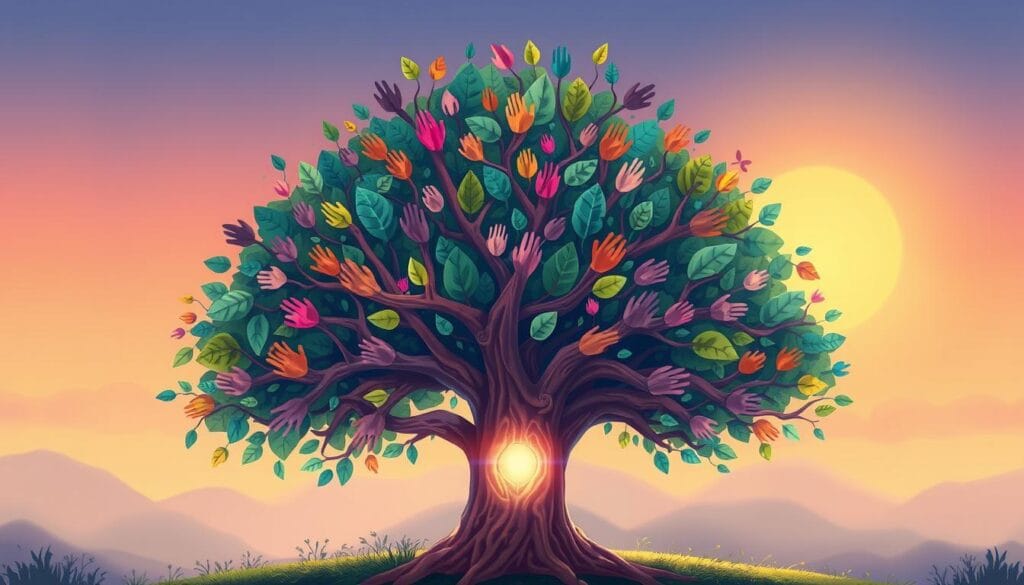
You don't have to face anxiety and depression alone. Lean on your support systems for help. With the right support, you can overcome these challenges with strength and resilience.
Overcoming Stigma: Embracing Mental Health
It's key to tackle the stigma around mental health. This helps people feel okay to ask for help and care for their minds. Even though many face mental health issues, getting support is hard because of social and personal barriers.
Stigma can cause people to be judged or treated unfairly. It makes them shy away from getting help. It also leads to misunderstandings from family and friends, and can affect work and school life.
To beat these challenges, we need to understand mental health better. Joining groups like the National Alliance on Mental Illness (NAMI) helps. It teaches people about mental illness and fights stigma.
- Speak out against stigma to encourage others facing similar challenges and educate the public about mental illness.
- Seek treatment, as it can reduce symptoms interfering with work and personal life.
- Advocate for your rights, as discrimination against students with mental illness is illegal, and schools are required to provide accommodations and support services.
By reducing stigma and creating a more caring world, we help people focus on their mental health. This way, they can get the support they need to heal.
Conclusion
We hope this guide has helped you feel ready to improve your mental health. Cognitive Behavioral Therapy (CBT) is the best way to treat anxiety and depression. It has shown to be very effective in many studies.
Medicine can help too, but a mix of therapies, lifestyle changes, and community support is key. By taking care of yourself, changing negative thoughts, and facing fears, you can improve your mental health. This will make your life better overall.
You're not alone in this fight. Get help from licensed therapists and support from friends, family, and mental health advocates. Together, we can fight the stigma of anxiety and depression. This will help more people focus on their mental health and live happier lives.
FAQ
What are the symptoms and manifestations of anxiety and depression?
Anxiety and depression show many symptoms. These include too much worry, fear, and sadness. They also include feeling hopeless and affecting life and relationships.
What is the prevalence and impact of anxiety and depression?
Anxiety and depression are common worldwide. They affect millions of people. These conditions deeply impact daily life, relationships, and well-being.
How does cognitive behavioral therapy (CBT) work in the treatment of anxiety and depression?
CBT is a top treatment for anxiety and depression. It shows how thoughts, feelings, and actions are linked. By changing negative thoughts, people can feel better.
How does exposure therapy help in overcoming anxiety disorders?
Exposure therapy helps with anxiety disorders. It helps people face what scares them. This way, they can manage their anxiety and feel in control again.
How can mindfulness-based interventions complement cognitive behavioral therapy?
Mindfulness helps with CBT for anxiety and depression. It teaches being present and understanding feelings. This helps people handle stress better and accept themselves.
What are the key features and benefits of the best therapy options for addressing anxiety and depression?
Top therapies for anxiety and depression include CBT, exposure therapy, and mindfulness. They help change for the better. They also help people manage their mental health and feel better overall.
What does the research say about the effectiveness of cognitive behavioral therapy (CBT) in treating anxiety and depression?
Studies show CBT is very effective for anxiety and depression. It helps people feel better for a long time. It also helps them manage their mental health on their own.
What role can medications play in the treatment of anxiety and depression?
Medications like antidepressants can help with anxiety and depression. It's important to talk to a mental health expert about them. They can help find the right medication and watch for side effects.
How can lifestyle modifications support the management of anxiety and depression?
Changes in lifestyle, like exercise and sleep, can help with mental health. They work well with therapy. A holistic approach can improve well-being and help with challenges.
Why is it important to seek professional help for addressing anxiety and depression?
Getting help from mental health experts is key for anxiety and depression. They can create a treatment plan. They also help find the right therapist and check if therapy is working.
How can building a strong support system contribute to the recovery process for individuals with anxiety and depression?
A strong support system is vital for recovery. Connecting with family, friends, and support groups helps. It offers emotional support and understanding, which helps with healing.
How can we address the stigma surrounding mental health conditions and empower individuals to seek help?
We need to fight the stigma around mental health. By raising awareness and understanding, we can help people seek help. This creates a supportive environment for recovery.
Source Links
- Understanding Anxiety And Depression Symptoms & Treatment
- Best Neurologist In Patna, Author Dr Chandril Chugh
- Men's Health Risk Factors - Men Health Issues | Dr Gooddeed Clinic
- Computer Therapy for the Anxiety and Depressive Disorders Is Effective, Acceptable and Practical Health Care: A Meta-Analysis
Interpersonal Therapy for Depression: How It Works | Dr. Chandril Chugh
Depression is a silent battle that millions face every day. It affects their well-being and daily life. While treatable, social stigma and lack of resources often lead to it being ignored.
This article will look at treatment options for depression. We'll focus on interpersonal therapy, guided by Dr. Chandril Chugh, a top mental health expert in the U.S.
Interpersonal therapy for depression helps improve communication and address relationship issues. It also teaches healthier ways to cope. By focusing on social and interpersonal aspects, it aims to reduce depression symptoms and improve mental health.
Dr. Chandril Chugh uses this therapy to help patients deal with depression. He helps them regain their quality of life.
Understanding Depression: A Silent Battle
Depression is more than feeling sad. It's a serious mental health issue that can ruin your life. It's a quiet fight that millions face in the United States, with depression becoming more common.
The World Health Organization says depression affects over 264 million people worldwide. In the United States, about 21 million adults had a major depressive episode in 2020. This is 8.4% of the population.
Depression symptoms vary but often include sleep and appetite changes. You might also feel hopeless, guilty, or have physical pain. These feelings last more than two weeks and really hurt your life quality.
Many things can cause depression, like trauma, genetics, and brain changes. Knowing about depression's symptoms and causes is the first step to getting help.
It's important to understand depression to fight it well. Learning about depression's impact, symptoms, and causes helps us seek help. This way, we can break the silence and win the fight against depression.
Does Everyone with Depression Need Treatment?
Deciding to get treatment for depression isn't the same for everyone. Some people need help right away because their symptoms are very bad. Others might not need medication if their depression is mild. It's important to figure out how bad your symptoms are and talk to a doctor to find the right treatment.
Evaluating the Severity of Your Symptoms
It's key to know how bad your depression symptoms are. If you have mild depression, you might not need medicine. You could try changing your lifestyle or talking to a therapist instead. But, if your doctor thinks you might get worse, listen to their advice.
- Mild depression symptoms might make you feel sad or tired sometimes. They don't stop you from doing your daily stuff.
- Moderate depression symptoms can really mess up your life. They can affect your job, friends, and how you feel overall.
- Severe depression symptoms are very hard to deal with. They can make even simple tasks hard. This kind of depression usually needs a big treatment plan, including medicine and therapy.
Knowing how bad your depression is helps you and your doctor find the best treatment. It could be medicine, therapy, or both. The main goal is to find what works best for you and helps you feel better mentally.
The Importance of a Support System
Having a strong support system is key when dealing with depression, whether you're taking medication or not. This network can include family, friends, or others who have battled depression. Talking openly and staying connected can greatly help manage symptoms.
Depression is not a sign of weakness. It can hit anyone. Interpersonal Therapy (IPT) focuses on how we connect and communicate. It aims to improve our mental health by fixing issues in our relationships.
IPT works well for many, including teens and the elderly. It's a 12–20 session therapy that lasts 4–5 months. It's designed to tackle depression head-on.
Surrounding yourself with a supportive group can help you get through tough times. Whether it's family, friends, or mental health experts, having people who care can make a big difference. They offer emotional and practical support.
You don't have to face depression by yourself. Talk to your support group, stay connected, and seek help when needed. With their help, you can beat depression and improve your mental health.
Medication Options for Treating Depression
Medication is key in managing depression. It helps balance your mental health. There are many antidepressants and other meds, each with its own benefits. Knowing these options helps you find the right treatment with your doctor.
Antidepressants and Their Mechanisms
Antidepressants work by changing how neurotransmitters work in the brain. These chemicals, like serotonin and dopamine, help control mood. When they're out of balance, depression can happen.
- Selective Serotonin Reuptake Inhibitors (SSRIs) like Citalopram, Escitalopram, Fluoxetine, and Sertraline increase serotonin.
- Serotonin-Norepinephrine Reuptake Inhibitors (SNRIs) such as Duloxetine, Venlafaxine, and Desvenlafaxine boost serotonin and norepinephrine.
- Tricyclic antidepressants, including Imipramine and Nortriptyline, also affect serotonin and norepinephrine, but have more side effects.
- Monoamine Oxidase Inhibitors (MAOIs) like Tranylcypromine and Phenelzine are used when other meds don't work.
Doctors might mix antidepressants with other meds for better results. Genetic tests can show how you'll react to certain antidepressants.
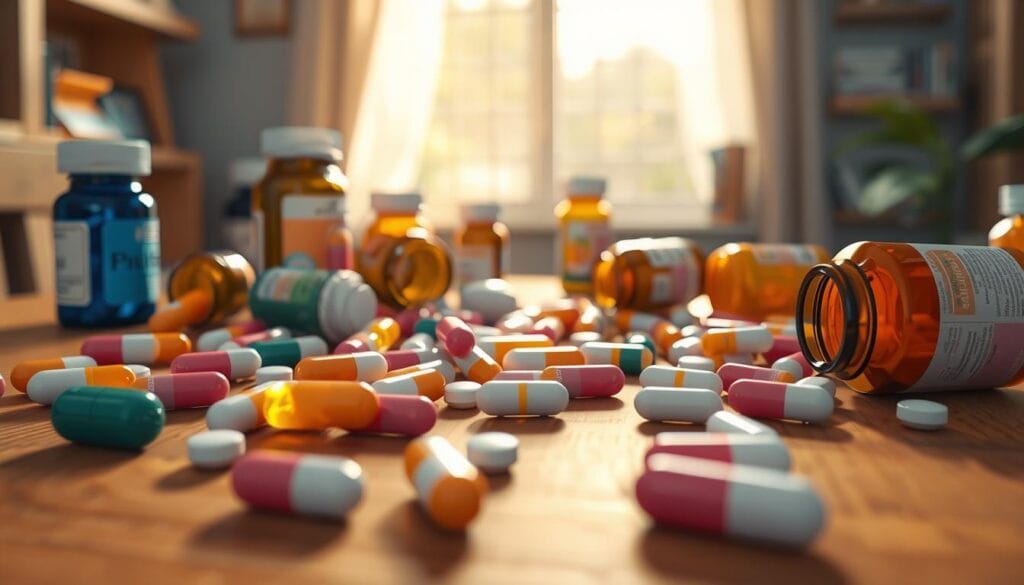
Remember, the FDA warns about a higher risk of suicidal thoughts in kids and teens with antidepressants. Your doctor will watch you closely at first.
Non-Medication Therapies for Depression
Managing depression doesn't always mean taking medication. There are many non-medication therapies that work well. These therapies help change negative thoughts and improve how we cope with life.
Cognitive-behavioral therapy (CBT) is a well-known therapy for depression. It helps people see how their thoughts, feelings, and actions are connected. This way, they can better manage their symptoms. Dialectical behavior therapy (DBT) also helps by teaching skills like mindfulness and emotion control.
Interpersonal therapy (IPT) focuses on how our relationships affect our mood. It helps people improve their communication and build stronger support systems. This therapy is great for dealing with tough life changes.
These therapies can be very helpful, and might be used alone or with medication. If you're dealing with depression, talk to your doctor about these options. They can help you find the best way to feel better.
Lifestyle Changes for Improved Mental Health
Managing depression can be helped by making lifestyle changes. Healthy habits in your daily life can boost your mental health. They work well with other treatments.
Incorporating Healthy Habits
Exercise, a balanced diet, and enough sleep are key for a healthy life. They help your mental health a lot. Studies show that good food and exercise can lower depression risk.
Deep breathing, meditation, or mindfulness can also help. They reduce stress and help you relax. Adding these to your self-care can be very helpful.
- Aim for at least 150 minutes of moderate-intensity physical activity and two days of muscle-strengthening activities per week, as recommended by the CDC.
- Prioritize a balanced diet that limits high sugar intake, as research has linked excessive sugar consumption to higher rates of depression.
- Establish a consistent sleep routine, as sleep problems are often an early sign of depression.
- Incorporate stress-reduction practices, such as deep breathing, meditation, or mindfulness, into your daily life.

By changing your lifestyle, you can improve your mental health. These changes can help with other treatments. Remember, small steps can lead to big improvements in your mental well-being.
Seeking Social Support and Self-Care
In your journey towards mental health recovery, seeking social support and prioritizing self-care is key. Research shows that social support protects mental health. It's vital for recovering from depression and mood disorders.
Building a supportive network with family and friends is important. It gives you a sense of belonging and emotional support. Doing things that make you feel good, like exercise or hobbies, helps fight depression. It gives you purpose and control.
Here are ways to add social support and self-care to your recovery:
- Reach out to trusted loved ones and share your experiences. Lean on them for emotional support and practical help.
- Join a support group, either in-person or online, to connect with others who understand you.
- Do things that bring you joy and a sense of accomplishment, like reading or gardening.
- Try relaxation techniques, such as deep breathing or yoga, to manage stress and improve well-being.
- Make self-care a priority, like getting enough sleep, eating well, and exercising regularly, for your mental and physical health.
By seeking social support and practicing self-care, you empower yourself on the path to mental health recovery. You find the strength to overcome depression's challenges.
Interpersonal Therapy for Depression: How It Works
If you're dealing with depression, IPT can help. It focuses on improving your relationships and how you talk to others. This can really change how you feel and live.
IPT helps you find and fix problems in your relationships. It teaches you how to have better relationships and ways to deal with tough times.
You'll have 12 to 16 sessions of IPT. You can do it alone or with others, in person or online. The main part of IPT lasts 12–16 weeks. It's best used when you're first getting treatment for depression.
But IPT can also help keep you from getting depressed again. It's good for many mental health issues.
With IPT, you and your therapist will look at how your relationships and life changes affect your mind. They'll teach you to talk better, deal with feelings of loss, and solve problems in your relationships. Studies show IPT works as well as CBT for depression. It can also help with eating disorders and anxiety.
At times, IPT and medicine together work better than either one alone. You might need to see your therapist more often if you have a long-term condition. IPT is for people of all ages, from teens to seniors. It's a flexible way to tackle depression at any stage of life.
If you want to try interpersonal therapy for depression, talk to your doctor. They can see if it's right for you and guide you on what to do next.

The Role of Dr. Chandril Chugh
Dr. Chandril Chugh is a top mental health expert. He helps people find effective treatments for depression. He has over 16 years of experience and focuses on each patient's needs.
Dr. Chugh is known for his knowledge in mental health, especially depression. He cares deeply for his patients. He makes sure they get the help they need to get better.
He uses many treatments for depression, like medicine and therapy. He also helps with lifestyle changes. This keeps his treatments up-to-date and effective.
Working with Dr. Chugh means getting a caring and personal experience. He listens to each patient's concerns. This helps them feel empowered and leads to better results.
If you're dealing with depression, Dr. Chugh can help a lot. His care and knowledge can improve your mental health.
Conclusion
Depression is treatable. With the right help, you can take back control of your mental health. There are many ways to manage symptoms and improve your life.
Interpersonal therapy (IPT) is a proven method. It helps people deal with relationship issues and big life changes. Studies show it can make a big difference in how you feel.
Start by getting professional help and building a support network. Making healthy lifestyle changes can also help. Remember, everyone is different, so it might take some time to find what works for you. But with effort and determination, you can beat depression and feel better.
FAQ
What is depression and how common is it in the United States?
Depression is a deep feeling of hopelessness and sadness. It affects many people of all ages and backgrounds. In the United States, it is one of the most common mental health issues.
Do all individuals with mild depression symptoms require medication?
Not everyone with mild depression needs medicine. The decision to use medication depends on how severe the symptoms are. If a doctor suggests starting medication, it's important to listen to their advice.
Why is having a strong support system crucial for managing depression?
Talking to others and being around people can help a lot with depression. It can even save lives, especially for those with both depression and anxiety. Having a strong support network is key.
What are the different medication options for the treatment of depression?
There are many medicines for depression, like antidepressants and benzodiazepines. These medicines help by changing how the brain works. They can make more serotonin and epinephrine or stop them from being broken down.
What are some non-medication therapies for the treatment of depression?
Besides medicine, there are other ways to treat depression. Cognitive-behavioral therapy (CBT) and dialectical behavior therapy (DBT) are examples. These therapies help change negative thoughts and improve how you cope with life.
How can lifestyle changes contribute to managing depression?
Changing your lifestyle can also help with depression. Exercise, eating well, sleeping enough, and reducing stress are all important. Adding these healthy habits to your day can help your mental health a lot.
What is interpersonal therapy, and how can it help with depression?
Interpersonal therapy for depression focuses on improving your relationships and how you communicate. It helps you deal with problems in your relationships that might be making you feel sad. This therapy gives you tools for better relationships and coping.
Who is Dr. Chandril Chugh, and what is his expertise in treating depression?
Dr. Chandril Chugh is a top brain expert with lots of medical training in the U.S. He has over 16 years of experience and is known for his caring approach. Dr. Chugh is great at treating mental health issues like depression.
Source Links
- Strategies For Managing Mood Swings Effectively | Dr Chandril Chugh
- Best Neurologist In Patna, Author Dr Chandril Chugh
- Understanding Depression | Southern CT Behavioral Health
Breastfeeding and Postpartum Depression: What You Should Know | Dr. Chandril Chugh
Breastfeeding is known for its many benefits. But it can also affect your mental health. About 10-20% of new moms get postpartum depression, and breastfeeding moms might be at higher risk.
It's key to understand how breastfeeding and mental health are connected. This knowledge helps support and care for new moms better.
In this article, Dr. Chandril Chugh shares the latest on this topic. Dr. Chugh talks about why we must tackle postpartum depression. He also looks at how breastfeeding affects a mom's mental health.
Introduction to Breastfeeding and Postpartum Depression
Breastfeeding is good for both mom and baby. But, it might also raise the risk of postpartum depression in moms. We'll look into how breastfeeding mental health and postpartum depression symptoms are linked in new moms.
Understanding the Connection Between Breastfeeding and Mental Health
There's a complex link between breastfeeding and postpartum depression. Some studies say longer breastfeeding might lower depression risk. But, others find breastfeeding doesn't shield moms from postpartum depression risk factors.
Exploring the Importance of Addressing Postpartum Depression
Postpartum depression can harm both mom and baby. It affects up to 19.6% of new moms in low-income countries. It's key to tackle this to ensure family health and happiness.
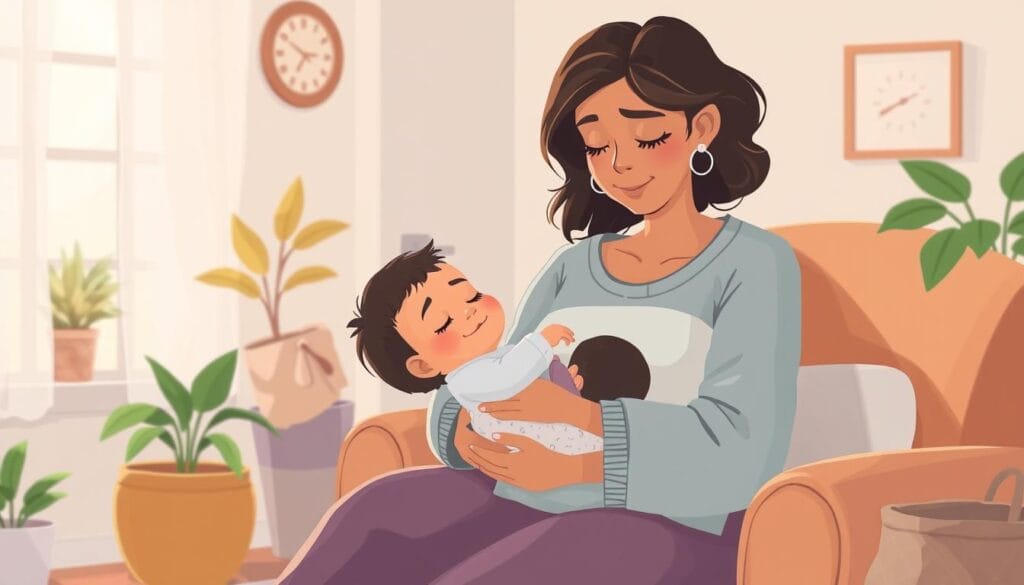
Benefits of Breastfeeding for Mother and Baby
Breastfeeding is great for both mom and baby. It helps babies avoid many health problems. These include infections, diarrhea, ear infections, and obesity. It also helps them grow well and have a strong immune system.
For the mom, breastfeeding can make her feel better after having a baby. It can help lower the risk of feeling sad or depressed after childbirth. This is because breastfeeding can make a mom's mood and feelings better.
It's also good for the mom's health. It can lower the risk of breast cancer, ovarian cancer, high blood pressure, and Type 2 diabetes. Breastfeeding for more than a year can make these risks even lower.
Babies who are breastfed often get sick less and are healthier. Doctors usually suggest breastfeeding for at least six months. This is to make sure the baby gets the most benefits.
But, some things can make it hard to breastfeed only. Medical issues, surgeries, or work can be examples. If you're having trouble, talking to a lactation consultant or a breastfeeding medicine expert can help.
Challenges and Barriers to Breastfeeding
Many mothers face big challenges when trying to breastfeed. In the United States, some think it's hard or that bottle-feeding is easier. They might also believe chubby babies are healthier, which isn't true.
Only 25.4% of women in the U.S. are still breastfeeding at 6 months. About 45% stop too early, which is not good.
Lack of Support and Resources for Breastfeeding Mothers
Not enough support and resources are available for breastfeeding moms. At birth, over 83% of U.S. babies are breastfed. But this number goes down fast.
This drop is because many moms don't get the help they need. Workplaces also often aren't friendly to breastfeeding.
We need to help more by giving moms the support they deserve. Healthcare providers, employers, and communities must work together. This will help moms breastfeed successfully.
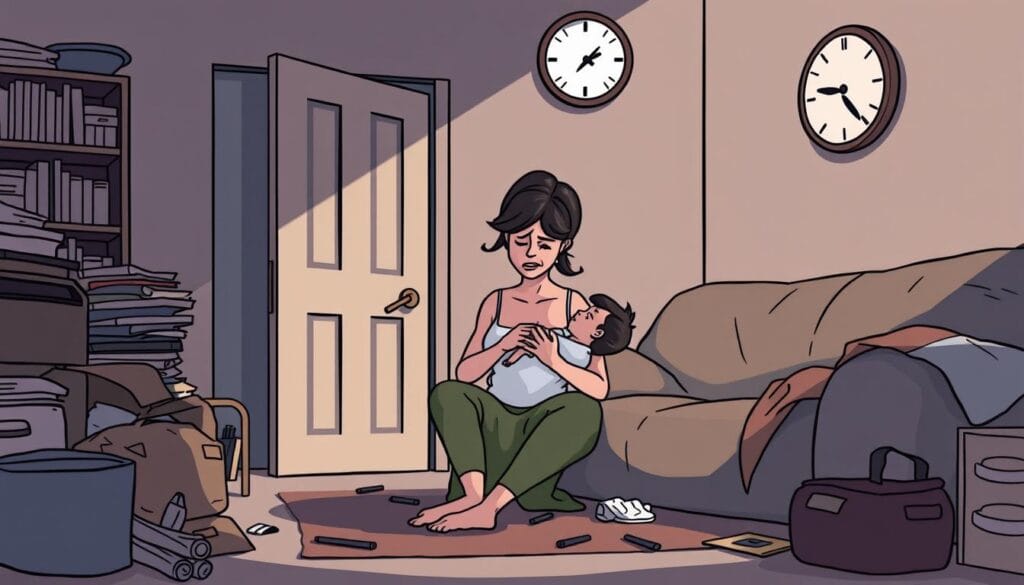
Factors Contributing to Decreased Breastfeeding Rates
In developing countries, things are even harder. There's less education and poor healthcare access. False beliefs about breastfeeding also play a part.
To solve these problems, we need a plan that tackles both personal and big issues. By doing this, we can help more moms breastfeed. This is good for both mom and baby.
Breastfeeding and postpartum depression
Postpartum depression is a serious mental health issue that can hit new moms, even those who breastfeed. Studies show breastfeeding moms might face a higher risk of this condition. About 10-15% of new moms in the U.S. deal with postpartum depression. Those who didn't breastfeed exclusively had a 89% higher risk.
Stopping breastfeeding can lead to more depression, research shows. Moms who faced pain, infections, or issues with latching were more likely to feel depressed. This shows why we need to support breastfeeding moms through tough times.
A study with over 2,500 women found a link between negative breastfeeding feelings and depression. Women who felt pain or had issues soon after birth were more likely to feel depressed at two months. Also, moms who wanted to breastfeed but couldn't were more likely to feel depressed.
It's key to understand postpartum depression in breastfeeding moms to help them. Early support for breastfeeding can lower depression risk. But, moms should be allowed to stop if they face big challenges.

Impact of Breastfeeding on Maternal Mental Health
Breastfeeding can deeply affect a mother's mental health. Hormonal changes, like more prolactin and oxytocin, can change her mood. But, breastfeeding's demands can lead to sleep loss, tiredness, and a higher risk of depression after birth.
Hormonal Changes and Emotional Well-being
When a mother breastfeeds, her body changes a lot. The rise in prolactin helps her feel calm and bond with her baby. Oxytocin, known as the "love hormone," also boosts her nurturing side.
But, breastfeeding can also be hard on a mother's mood. The constant feedings and sleep loss can make her feel very tired and stressed. This shows how important it is to care for a new mother's mental health.

Studies on breastfeeding and mental health are mixed. Some say breastfeeding helps against anxiety and depression. But, others find it can make mental health issues worse. It's key to understand how hormones, emotions, and breastfeeding work together to help new mothers.
Supporting Breastfeeding Mothers with Postpartum Depression
It's very important to support breastfeeding moms with postpartum depression. This condition can make it hard for them to care for their babies. But, with the right help, they can get through it and keep breastfeeding.
Importance of Social and Emotional Support
Support from family and friends is key for these moms. Feeling alone can make things worse. By talking openly and helping out, loved ones can make a big difference. They can offer the emotional support needed.
Coping Strategies and Professional Help
There are many ways to help these moms. Support groups, both online and in-person, are great. They let moms share and get advice. Professional counseling is also very helpful.
Self-care is important too. Getting enough sleep, eating well, and drinking water helps. Taking care of oneself makes it easier to handle the challenges of breastfeeding and parenting.
With the right support for breastfeeding mothers with postpartum depression, emotional support for breastfeeding mothers, and coping strategies for postpartum depression, moms can beat the odds. They can keep a healthy breastfeeding relationship with their babies.
Balancing Breastfeeding and Self-Care
As a new mom, taking care of yourself is key while breastfeeding. It helps keep your mind and body healthy. This can lower the chance of feeling down after having a baby. By focusing on rest, eating right, and drinking water, you can handle breastfeeding better. This way, you'll have the energy to take care of your baby.
Prioritizing Rest, Nutrition, and Hydration
Breastfeeding can be hard on your body and mind. So, it's important to take care of yourself. Try to rest, even if it's just a short nap. Eating well and drinking water will keep you energized and help your body heal.
Here are some self-care tips for your daily routine:
- Do relaxing things while breastfeeding, like meditating, listening to music, or reading.
- Make healthy snacks and meals ahead of time. This way, you'll have good food ready.
- Always carry a water bottle. Drink water often to stay hydrated.
- Ask your partner, family, or friends for help with chores. This lets you focus on yourself.
By taking care of yourself while breastfeeding, you can handle the challenges of being a new mom. This supports your overall health and well-being.
Role of Healthcare Providers and Family
Healthcare providers and a new mother's family are key in supporting breastfeeding and managing postpartum depression. Healthcare providers must give the right education and resources. This helps breastfeeding mothers and guides them through the postpartum period.
Providing Appropriate Education and Resources
Healthcare providers should be ready to:
- Educate new mothers on breastfeeding techniques and strategies to manage common challenges
- Offer guidance on recognizing and coping with postpartum depression
- Provide information on available resources and support services for breastfeeding mothers
- Encourage open communication and foster a safe, non-judgmental environment for mothers to share their experiences
Family members can also be very helpful. They can:
- Offer practical assistance with household tasks and caring for the baby
- Provide emotional support and a nurturing environment for the new mother
- Encourage the mother to prioritize self-care and rest
- Advocate for the mother's needs and help her navigate the postpartum period
Together, healthcare providers and family members can ensure breastfeeding mothers get the support they need. This support helps them navigate the postpartum period and overcome challenges like postpartum depression.
Conclusion
Breastfeeding is good for both mom and baby. But, it can also affect a mom's mental health. Postpartum depression hits 10-20% of new moms in the U.S.
It's key to understand how breastfeeding and mental health are linked. We must support both mom and baby well.
Helping new moms with breastfeeding challenges is important. This includes lack of support and resources. It helps moms focus on their mental health and enjoy breastfeeding.
In places like Clark County, Nevada, postpartum depression rates are higher. We need to tackle this issue.
Supporting moms with postpartum depression is vital. This includes counseling, coping strategies, and self-care. It ensures new moms get the help they need to do well.
The link between breastfeeding and postpartum depression is clear. We must support breastfeeding moms' mental health. This is key for family well-being.
FAQ
What are the benefits of breastfeeding for the mother and the baby?
Breastfeeding is great for both mom and baby. It helps babies avoid many health issues. These include infections and obesity. It also helps them grow well and have a strong immune system.
For moms, it can help prevent depression. It makes them feel better emotionally.
What are the common challenges and barriers to breastfeeding?
In rich countries, some moms think it's hard. They might find bottle-feeding easier. They might also worry about their baby's weight.
Workplaces that don't support breastfeeding are a big problem. In poor countries, lack of education and healthcare is a big issue. False beliefs about breastfeeding also play a role.
What is the prevalence of postpartum depression among breastfeeding mothers?
Research shows breastfeeding moms might get postpartum depression more often. About 10-20% of new moms feel this way. Those who didn't breastfeed exclusively were 89% more likely to get it.
How can breastfeeding impact a mother's mental health?
Hormones like prolactin and oxytocin can make moms feel better. But, breastfeeding can also make moms very tired. This can lead to depression.
What are the key strategies for supporting breastfeeding mothers with postpartum depression?
Moms need support from loved ones. They should join support groups and see counselors. This helps them feel less alone and stressed.
Rest, eating well, and drinking water are also important. These help moms handle breastfeeding and depression.
What is the role of healthcare providers and family in supporting breastfeeding mothers?
Doctors should teach new moms about breastfeeding. They should also help with depression. Family can help with chores and caring for the baby.
They can make a safe and loving space for the new mom.
Source Links
- Are Breastfeeding Mothers More Prone to Depression? Here is What Experts Say
- Content Posted in 2021 | Providence St. Joseph Health Digital Commons
- Breastfeeding Status and Duration Impact Postpartum Depression Risk
- Frontiers | Postpartum Depressive Symptoms and Their Selected Psychological Predictors in Breast-, Mixed and Formula-Feeding Mothers










